#story analysis
Text
Sir Pentious' Death

So there's something glorious about Sir Pentious' death being INglorious.
It proves that redemption isn't about success.
What makes Sir Pentious worthy of Heaven isn't that he hurt Adam with his final attack. That'd be one thing, but this is Heaven, not Valhalla; great and epic feats of warfare are not what earns one a ticket to the Pearly Gates.
It is the courage and willingness to die to save others- i.e. not the act itself, but the decision to perform the act- that is the mark of glory, that evinces the greatness that makes redemption possible.
And we've even seen him develop this courage in a smaller subplot: look how he started out with talking to Cherri in the last episode!

But eventually he got the gumption to tell Cherri how he felt, in the most dramatic way possible.
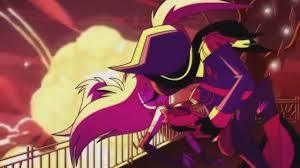
Sir Pentious changed, and THAT change is what propelled him to make the decision to risk his life- a risk that became entirely real- to save his friends.
Letting Adam wipe out Sir Pentious, beyond being a good way to really establish just how damn STRONG Adam really was, shows that his redemption wasn't about Sir Pentious' success.
It was about Sir Pentious' heart, who he was inside.
And it was enough to earn him not just Heaven, but to appear there before the Seraphim themselves.
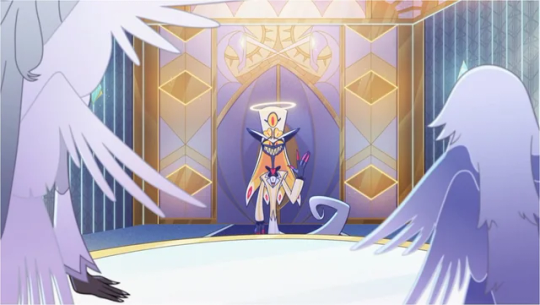
And you can see the heart on his design, on his bowtie!

#sir pentious#adam#hazbin hotel#spoilers#hazbin hotel spoilers#cherri bomb#sir pentious x cherri bomb#i ship it#:D#emily#sera#character analysis#death analysis#finale#hazbin hotel finale#redemption#death#character death#story analysis#story themes#themes#thematic analysis
234 notes
·
View notes
Text
Atlantis: the Lost Empire subverts the "White Savior" trope so well and here's my Ted talk tangent
Atlantis: the Lost Empire is just Avatar but with a smarter story. Both films feature a young white man discovering a foreign culture, falling for the culture's princess, and saving the natives' way of life. Both films commentate on the exploitation of indigenous people for their resources. The biggest fundamental difference between Avatar and Atlantis is how the white male leads approach their scenarios. Milo Thatch is a wide-eyed scholar who just wants to learn; Jake Sullivan is a soldier infiltrating the culture so he can exploit them. Milo never had any intention of hurting/exploiting the natives but the people around him did; Jake knew the end goal was exploitation and only changed his alliance when he fell in love. Kida comes to Milo for help and he approaches her with respect not condescension; Jake has to learn the planet and its people are worthy of respect. Milo is attracted to Kida but he doesn't save her so he can get the girl; he saves her to save her people (getting the girl was a luxury and even then, it's obvious they'll take things slow cuz there's more important things than romance like reconnecting the Atlanteans with the lost parts of their culture). The Atlanteans are also not harmless, primitive natives. They had super-advanced technology ie the Leviathan that took out a modern submarine in like 2 minutes while the Navi are overtly primitive, their simplicity treated as a virtue. The Atlanteans were so advanced that they sent themselves back to the Stone Age with their war tech. This little detail keeps the Atlanteans from being hippie-dippie natives who need rescuing and make them a cautionary tale; they used to be greedy, hyper-advanced warmongers and that hubris leaves their race and culture on the verge of extinction. Both the Navi and Atlanteans have spiritual, mystical aspects to them, but the Navi are anti-tech while it's only the rediscovery of their tech that allows the Atlanteans to save themselves. The primitive life we see the Atlanteans lead is not presented as ideal; it is the death throes of a culture, a fatal stagnation at the bottom of the world. When Kida and Milo meet, it's not the typical "more advanced culture taking from the weaker culture" that has come to define first contact between societies. It's quid pro quo: we both answer, we both listen, we both come away with more not one party coming away with less. No one is humbled or talked down to. As for the antagonists of both films (Avatar and Atlantis) the antagonists of Avatar are just cardboard cutouts. The antagonists of Atlantis are just disinherited individuals coming together for a treasure hunt. There's a gag where Milo asks what each character seeks and they all say "Money" but that's not it. They each want to pursue goals unique to them and they need money to do it. When the chips are down and it's either money or NOT dooming an entire lost tribe to death, they choose saving the tribe. The main big bads, Rourke and Helga, have just spent a day walking through a ruined city where people live in the remains of their greatness and think, "Yeah, we are so stealing their technology so we can reenact the fall of their civilization on our OWN civilization. Why? Cuz capitalism." Why am I talking so much about Atlantis but not Avatar? Because Avatar lacks depth. I've watched Atlantis a thousand times on my cheap 2000s-era TV and get pulled in each time but Avatar's just a pretty screensaver playing in the background.
#ted talks#tangents#atlantis the lost empire#milo thatch#atlantis#disney atlantis#kidagakash#avatar#avatar way of water#jakesullivan#jake sully#white savior#story analysis#commentary#anti capitalism#capitalism#james cameron#corporate greed#worldbuilding#rant#personal rant#rourke#miles quaritch#helga sinclair#kidada jones#disney animation
239 notes
·
View notes
Text
Okay so Murder Drones Episode 7 clarified a lot about what's going on, and I think I now mostly understand The Plot. Pulling my thoughts together into a rough timeline (warning, this is looong, major spoilers obv):
The setting:
Humanity is in the space age, having colonized other planets like Copper 9.
The company "JCJenson IN SPAAAAACEE!!!!" appears to have invented sentient robots, called worker drones.
Worker drones have no rights and are treated poorly.
Worker drones have a known "bug": if a dead worker drone's core is left alone in the body, it has a ~0.01% chance of coming back to life (a "zombie drone").
JCJenson has a fix for this, called "wdOS_606" (assumed to stand for "Worker Drone Operating System 606"). It's installed in dead worker drones to prevent reanimation, but in some cases the dead body can "reject" the update (even after lying dormant for up to five years!) so users are instructed to remove the core and destroy the body, too.
If a drone does reanimate, there's 70.3% chance that everything is fine and the drone is just alive again, a 29% chance of undergoing "terminal lockout", and a 0.7% chance to reboot with "potentially hazardous mutations".

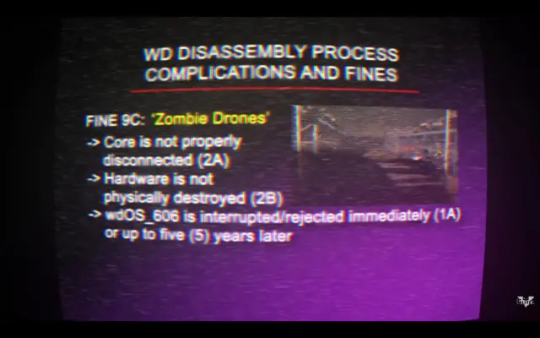

So if you do absolutely everything wrong, there's a ~0.00007% chance of "potentially hazardous mutations".
That's probably fine.
The backstory:
Someone does absolutely everything wrong. An improperly discarded worker drone awakes in a mass grave of other drones.
This drone is recovered by Tessa James Elliott, heir to the Elliott fortune, who names her "Cyn".
Tessa has a fascination with worker drones, treating them like people and dressing them up as butlers and maids (much to her parents' annoyance). In addition to Cyn, she has three other worker drone rescues, who she has named "N", "V", and "J".
Unbeknownst to Tessa and the other drones, Cyn is one of those 0.00007%. She has a something called "Absolute Solver".
Exactly how much of the original Cyn is left in there is unclear. Exactly what Absolute Solver is is also unclear. (Personal theory: JCJenson didn't actually invent sentient AI. They found some eldritch alien technology, reverse engineered it, locked the original programming down under a giant pile of safeguards, and referred to it as "potentially hazardous mutations" in the user manual. But that's just speculation.)
Whatever it is, Absolute Solver is obscenely powerful and dangerous. It can manipulate objects telekinetically with extreme force and precision, regenerate from virtually any injury, project expansive life-like holograms, generate massive bio-mechanical extensions to its body and surroundings, and create "null" zones capable of shattering a planet with the correct placement.
During this time J and Tessa regularly keep Cyn locked in the manor's basement at the request of Tessa's mother, who finds her disturbing.
Absolute Solver / Cyn spreads itself into N, V, and J without their knowledge and spends its time cloning and experimenting on them down there, wiping their memories to prevent them from noticing.
Eventually, Absolute Solver / Cyn attacks a gala the Elliotts are holding, killing most or all of the guests and taking full control of N, V, and J.
Either at the gala or later, Absolute Solver / Cyn takes Tessa's body. It's not entirely clear whether AS killed Tessa and is wearing her body like a suit, or whether Tessa is still "alive" in some way (which would be even worse IMO).
Absolute Solver fully mutates N, V, and J into their murder drone forms, cloning them and using them as soldiers in the genocide of Earth. Their original minds are mostly suppressed during this time.
Earth is eventually fully destroyed, presumably by nuking its core with a null zone, and the wave of "disassembly drones" starts spreading out to other colonized planets.
The common worker drones on Copper 9 apparently never find out about any of this?

As the wave closes in, the JCJenson outpost on Copper 9 starts doing secret experiments on worker drones that are infected with Absolute Solver, under the code name "Cabin Fever".
For safety, the scientists stock the underground labs with anti-drone sentinels, raptor-like robots programmed to freeze and destroy worker drones.
Some of the worker drones they experiment on never gain any powers. The ones that do eventually become corrupted by Absolute Solver / Cyn and have to be put down. By the time of the final experiment, only two successful experiments remain: 002 Nori (Uzi's mom) and 048 Yeva (Doll's mom).
The scientists manage to develop a patch that can suppress Absolute Solver's influence. The patch is successfully installed into Yeva, but Nori has already been corrupted by Absolute Solver by this point. The scientists frantically struggle to install the patch into her as well.
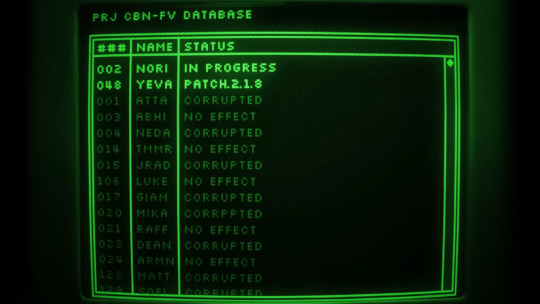
During this final procedure, for reasons unknown, the intended lead scientist Dr. Chambers never shows up. His hazard suit and name tag are mistakenly taken by Mitchel, the world's unluckiest intern.
Absolute Solver / Nori is rampaging out of control. Dr. Ridley hopes that Yeva can subdue her with her powers, and due to the mix-up sends Mitchel to fetch her.
While Mitchel is gone Absolute Solver / Nori kills everyone in the cathedral lab (except for Dr. Ridley), gets rid of the sentinels, and projects a hologram to disguise the killing.
Mitchel returns with Yeva, but finds the situation seemingly under control and the patch already installed into Nori. He wasn't sure what he was supposed to do with Yeva in the first place, so with the danger apparently passed he leaves her outside and claims he never found her.
Mitchel leans down to pick up what he assumes is a spare copy of the patch (it's actually the original), and freezes as he spots Dr. Ridley hiding silently behind a pew. Absolute Solver / Nori kills Dr. Ridley and drops the hologram, then flings the patch USB at Mitchel's face to kill him too.
Yeva catches the USB before it hits him, having followed him inside, although the sheer wind force shatters Mitchel's visor and breaks his suit camera. She flings the USB back at Nori, successfully "plugging" it into her at last.
Before being fully suppressed, Absolute Solver throws the USB down a giant hole and generates a null zone in Nori's hand. Yeva slices the hand off and lets it fall into the hole, too. The null zone explodes, partially shattering the planet and killing all human life (rip Mitchel).

Nori and Yeva escape to the surface and join the newly forming worker drone society. One of the failed experimentees, Alice, remains below and begins scavenging parts from worker drones that have been killed by the roaming sentinels.
Nori and Yeva have children (however that works), Uzi and Doll respectively. Although it is not yet obvious, their children inherit the suppressed Absolute Solver.
The main Absolute Solver / Cyn construct was watching these events from Earth to the best of its ability. Faced with the threat of other drones that share its powers but are not under its control, it reprograms N, V, and J to wipe out all the worker drones on Copper 9.

Under the reprogramming, they mostly regain their original personalities (seemingly due to a twisted sense of sentimentality-slash-sadism) but are given false memories of being built by JCJenson to suppress the worker drone uprising.
Their abilities are "nerfed" to prevent them becoming a threat to Absolute Solver. This may be why they need to consume worker drone oil so frequently, although Uzi and Doll have that urge too. Their ship is also intentionally crash landed to prevent them from returning, and the radio is removed to prevent them discovering the truth.
It's possible that J's reprogramming was different, as she "was getting orders from someone."
In one of their early attacks, the disassembly drones "kill" Nori, but she manages to survive and escape as a core using her Absolute Solver powers. She returns to the underground lab to search for the dropped USB, never telling Khan she's alive. Presumably her goal is to use the patch to stop Absolute Solver / Cyn and the disassembly drones.
V also kills Yeva and her husband, apparently for good. The trauma awakens Doll's Absolute Solver powers.
Khan builds the doors to hide the remaining worker drones from the disassembly drones.
With her powers awakened, Doll needs to consume oil. She begins secretly killing her classmates to survive and training her powers so she can avenge her parents by killing V. Lizzy finds out and fully supports her friend's serial killing / revenge plan.
The present:
Uzi manages to befriend N, leading him to start questioning the corporate propaganda he's been reprogrammed with.
Uzi and N fight V and J. J is seemingly killed, and N confines V to the ship. In reality J's Absolute Solver awakens and takes control of her body, now reduced to a core. V could escape if she chose, but refrains for now, seemingly conflicted.
Uzi's Absolute Solver powers begin to awaken.
Absolute Solver / J stalks and kills several worker drones using holograms, seemingly for materials to construct a new body. N and Uzi fight and eventually defeat it. N repeatedly stabs its core with his nanite acid, collapsing it into a small void that drifts away. It's not entirely clear whether it's dead or not.

Offscreen, Lizzy starts hanging out with V? In the ship, I guess?? and forms a semi-sorta friendship with her. Her intention seems to have been to mention prom, so that V would get the idea to go there for murder and Doll could kill her. (The Promening is kind of a dense and confusing episode and several characters have less than clear motivations.)
Uzi begins to notice the disappearances caused by Doll's killings, but is prevented from investigating by Khan, who attempts to distract her from all that creepy stuff with prom.
Doll attempts to isolate and kill Uzi, with Lizzy's support. Uzi finds the bodies of Doll's previous victims and escapes. Lizzy goes to let V inside.
V escapes from the ship and heads to prom with the intention of killing everyone. N follows to stop her, joined by Uzi.
Doll crowns herself the prom queen, having murdered all the other candidates. I have no earthly idea why she did this, other than that the murderous psychic girl was crowned prom queen in Carrie (for different reasons) and this episode is a light Carrie reference.
V descends on the prom with murderous intent, but is suddenly distracted by the prospect of becoming prom queen. Lizzy declares that V is her friend and peer pressures the other students into forgiving V and declaring her prom queen. Lizzy eventually decides that V is "hotter than Doll" and warns her to run just as Doll attacks.

Doll and V fight, killing tons of students nobody cares about. Uzi and N enter the fray, finding themselves defending V instead of stopping her.
Doll and Uzi both attempt to convince the other to join them in taking revenge on / working with the disassembly drones, without success.
Lizzy helps V, cementing their weird semi-friendship.
Doll discovers that Uzi also has Absolute Solver powers and says she's sorry for her. She escapes, saying she's going to search for a cure and promising to help Uzi if she does.
Uzi's oil cravings begin to get worse.
Absolute Solver / Cyn / Tessa (who I will now call Skyn) arrives on Copper 9 to finish the job her disassembly drones couldn't. She is accompanied by a J clone. Their cover story is that Tessa is working for JCJenson to stop Absolute Solver. It's not yet clear whether this J is aware of the truth or has false memories.
At some point, Skyn and J meet with Doll and give her some information about operation Cabin Fever. Doll agrees to find the key they need to get into the underground labs if they take her with them.
Doll travels to Camp 98.7, a former facility used in the Cabin Fever experiments, to find the key. N and Uzi follow her there to try and figure out what's going on. They bring V and all Uzi's surviving classmates too because why not.
Uzi finds a green robot-bug which has the keycodes, though she doesn't know this yet. N finds a VHS tape describing zombie drones.
Uzi's corruption gets worse. She loses control and kills several of her classmates. V fights Uzi, addressing her as "Cyn", but N manages to calm her down.
N has been recovering partial memories of his time in Elliott Manor, and while at a not-sleepover at Uzi's he and V collapse as their reprogramming tries to delete those memories, pulling them into a memory of the night of the gala. Interestingly, their screens display "Error: 606" during this time, suggesting a connection to "Worker Drone Operating System 606", the operating system intended to prevent zombie drones.

Uzi hacks into N and V's brains to protect their minds and to recover the memories in full. As she's doing this, Doll breaks into Uzi's home and steals the key-bug. Torn between saving her friends and letting the one clue she's found slip away, Uzi decides to help N and V.
Uzi helps N and V successfully recover their memories of the gala. Uzi sets herself as their system admin to prevent further tampering.
They follow Doll to her rendezvous with Skyn and J, shocking everyone. While Skyn (pretending to be Tessa) explains her cover story, Doll runs off with the key and ducks into the office complex leading to the lab.
Everyone else follows her, fending off sentinels and Alice, that ex-experimentee, along the way. Skyn tells N that Uzi is infected and must be killed for the good of the universe, a half-truth meant to drive a wedge between them as Skyn A) is the Absolute Solver, and B) knows about the patch. Alice is killed by sentinels.
One sentinel manages to wound Skyn and goes berserk, probably due to the paradox of a creature that is both human and worker drone.
They find Doll seemingly frozen by the sentinels, but it's a trap. Doll uses the key to summon an elevator down to the labs, opening her own way and leaving them cut off, surrounded by sentinels. V sacrifices herself to let them escape.
Down in the labs, Skyn continue to push Uzi away from N, freaking Uzi out and leading her to accidentally collapse the tunnel, separating all three of them.
With "Tessa" missing, Skyn returns to her Cyn form and torments N with illusions of V, dragging him away to be eaten. He is saved by Nori, who in an amazing coincidence has just today found that patch USB she's spent all these years searching for.
Uzi finds Mitchel's suit cam recordings of the final experiment, seeing her mother horrifically possessed by the Absolute Solver but not the moment when she was cured.
Returning to her Skyn-suit, Skyn accesses and deletes all the Cabin Fever team's notes, while J destroys the disassembly drones' ship on the surface, leaving Skyn and J's ship as the only way off the planet.
Skyn is confronted by Doll, who demands to know where the patch USB is, determined not to let Absolute Solver use her to destroy the planet (which was never actually its plan). Skyn does a funny Five Nights at Freddy's reference and fatally wounds her.
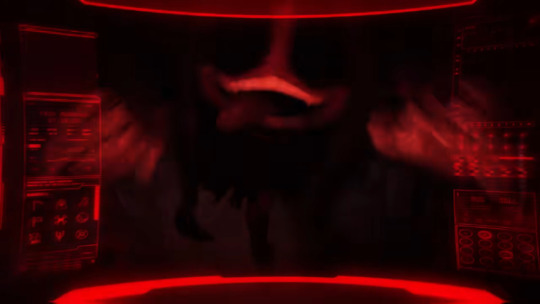
Nori catches N up on her backstory and the two try to figure out whether Doll or Uzi was the Absolute Solver that just attacked them, unaware of Skyn. Nori makes N promise not to tell Uzi that she's her mother.
Doll, bleeding heavily (a thing she can do thanks to Absolute Solver!) approaches Uzi and collapses. Skyn, re-disguised as Tessa (I swear she does like five costume changes in this episode she's so extra), follows Doll in and tries to kill Uzi, who is having the worst day of her life and is in no mental state to fight back.
N stops her and, determining that she did know about the patch and wanted to kill Uzi anyway, decapitates "Tessa". He tries to give the patch to Uzi, but she's already succumbed to Absolute Solver and destroys it.
N and Nori fight Absolute Solver / Cyn / Uzi. The fight goes poorly, and Absolute Solver / Uzi almost manages to eat Nori before N executes a flawless collective-embarrassment-jutsu, snapping Uzi out of it, but causing her to toss Nori into the giant pit. N spills the beans about Nori and both of them freak out in each other's arms.
Skyn finally reveals herself, devouring Doll's still-living core and beginning to yank Uzi and N into the pit as she prepares to detonate Copper 9's core just like Earth's and kill every remaining threat to her expansion.
J gets hit by a bus, loses her car keys, and is accosted by teens.
Uzi sacrifices herself to toss N the keys and get him out of there.
Uzi is pulled into the pit and somehow ends up in space, looking down at a big hole in Copper 9? Presumably the next episode will clear up what's going on here.
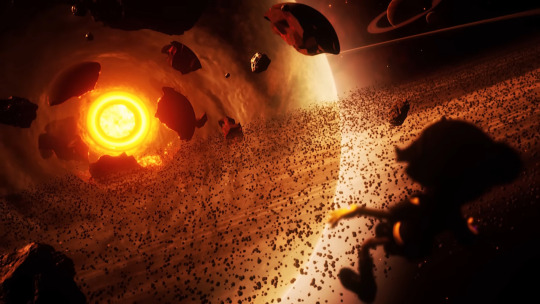
Which brings us up to the present.
#murder drones#md#murder drones spoilers#md spoilers#murder drones episode 7#murder drones ep 7#md episode 7#md ep 7#story analysis
97 notes
·
View notes
Text
So I was thinking about Iron Widow and the Hunger Games because superficially, they follow similar arcs; a teenaged girl from an oppressive system fights the government
They’ve both got commodified violence as entertainment, a powerful emphasis on glamorous photoshoots, and lots of sinister machinations for our leading ladies
But when you put them side to side, they’re extremely different, and not just in the themes they explore. I think it comes down to one thing: agency
Katniss is living a pretty rough life before her story starts, and her situation sucks, but she is almost entirely independent. She has people she loves and won’t lose, and can consider just vibing off into the woods, even if she never would
The community is on her side and show it periodically, but things go from bad to worse extremely fast for her
Her first enemies aren’t alien hordes or callous killers who’ve led a hundred girls to certain death; they’re just other kids, in the same shitty situation, and as much as she tries to hate them, she can’t
Katniss is reasonably and understandably traumatized by what she’s been through, and loses her agency at every step as she’s pulled around by other peoples’ plans. She doesn’t want the rebellion and she doesn’t want an army; she wants to go home and be safe
Oh, and her love triangle is missing a side
Zetian though? Zetian’s former life fucking sucks, and we meet her on page one ready and willing to die for what she wants because she has nothing left that is hers
She has tried to run away, enough times to have “yet another escape attempt”, and is completely dependent on the people around her. She’s told her life’s worthless until she believes it, but no one considered “what if she wants to go out with a bang”
Zetian does see the political picture immediately, even if her understanding is as vague as “stop killing girls”
And while the army does spend a time trying to torture her with starvation and neglect before she meets Shimin, it’s really not much worse than how she’s used to being treated
Getting on camera and into battle, into physical violence that she can strike back with rather than just receiving, is a liberation for Zetian, and gives her her first ever taste of agency and power
She’s the first Iron Widow to survive and bear the name in public because she’s the first who went live on camera after a battle and couldn’t just be swept under the rug
The army can’t afford to kill her, but she’s perfectly happy to die for what she wants and she pushes back immediately and constantly against anyone trying to control her. She capitulates only on her terms, only when she gains from it
She’s a happy bisexual with two proud bi boyfriends because fuck what anyone else in the universe says, she wants it and it’s hers. She’ll worry for a moment if she’s got to choose (and if she’ll accept the choice made for her) and promptly decides the whole thing can go fuck itself because only her (and the boys’) wants matter
Nobody wants Zetian to lead a movement and change their world; if she won’t die quietly in a chrysalis, they want her to stand quietly at Shimin’s side as an accessory to make him more powerful
Her life is immediately, materially better from the minute she survives a second battle, and arguably from the moment she enlists because it’s finally under her control
Tl;dr? Katniss’s story is about losing control of her life and everyone has something they want from her. Zetian’s story is about seizing control and doing the shit that absolutely nobody wants her to do because she can
Katniss doesn’t want to lead a revolution
Zetian’s not giving the world a choice because she’s a one woman army and is the revolution
#iron widow#the hunger games#spoilers#out of context spoilers#story analysis#hi i like to overthink things#so yeah if you liked katniss but wanted to see her go full feral#zetian is for you#these are both good and valid stories to tell#but i love a girl who crosses off every name on her kill list in book 1
4K notes
·
View notes
Text
How to Close-Read Anything to Learn From It
This year, I'm sharing a series of close reads with my Patrons. Join to participate in discussion, read my analysis, and hopefully we can all learn together from some masterful texts. This month we're talking about Eric LaRocca's novella We Can Never Leave This Place. Join here: https://www.patreon.com/tlbodine
But I also wanted to share my methodology here, because close reading is a skill you can use to improve your writing and learn from a text. You know how everyone says you need to read to become a better writer? Well. Here's one method of studying to learn from the masters. I'm not saying this is the ONLY way, but it's one I've gotten a lot of value from!
Step one: Grab a text. Ideally this should be one you enjoy, because you'll have to read through it multiple times. You can level up later by analyzing a book you hate.
Step two: Read the whole thing at least twice -- the first time to absorb the story, and the second time to start analyzing.
Step three: Begin the analysis.
You will want a notebook or something handy to start taking notes.
1 - Observe the structural elements. How long is it? How many chapters? How long is each chapter? How many scenes are there? How many plot events? Are there multiple scenes per chapter or just one? In any given scene, how much time is spent on dialogue, action, description? If you have a spare copy of the book and some colored highlighters, you might want to try highlighting different elements to see it visually.
2 - Write down everything that happens in the story. Try to write a 1-2 page synopsis of the entire book. This will help you keep things in place in your mind as you explore the story, and will also help you hone your skills of synopsis-writing for your own work. You may as well practice while you can!
3 - Write down each character, their role in the story, and their arc. What do they want? How do they change over the course of the story? How do they impact the events of the plot?
4 - What are recurring themes and motifs? How are those reflected in the language? How does the writing work on a line level? Are there poetic and rhetorical devices used? How do the writing techniques support what's going on with the story overall?
Finally, once you've written down all of these elements, what takeaways and conclusions can you draw? What works together? What seems to fall short? What would you do differently? What can you adopt for your own writing?
Practice this process. Internalize it. Learn from each thing you read. And then apply the same process to your own work when editing and polishing -- that's how you develop an objective editorial standard for your writing that will help you skill up.
#writing advice#writing tips#close reads#story analysis#reading comprehension#media criticism#long post
77 notes
·
View notes
Text
Young Royals and the three act structure, Part one
Seems like there was some potential interest in a full three-act story structure analysis, so I’m taking this opportunity to indulge myself by going full nerd. I’m going to attempt to make the argument that limiting the show to three seasons is actually perfect for Young Royals, by highlighting the pattern the story follows.
A few things to keep in mind before we start.
This analysis is not about the characters deep inner emotional lives. We are not here to pass judgment on their actions. We are simply identifying the beats of the story in a neutral and objective manner, for the purpose of analysing the structure of the story.
As you will notice, the points I have identified are all from Wilhelm’s perspective. That’s because he’s the point-of-view character, the main conflict is shaped by him and his emotional state. He’s the protagonist. Each subplot however, will follow the same pattern and has its own purpose, but I’ll get more into that another time.
I’ll be referring a fair bit to Lindsey Ellis’s video essay on the subject, because I like how she describes the structure pattern in sequences. So I’m gonna borrow some of her language. Also, note that the examples she uses to describe the tree-act structure are all feature films. Since Young Royals is a series, it’s gonna divert slightly from her description. But that’s what is so great about this structure, it’s flexible. It’s not meant to be set rules, but rather guidelines to help keep your story relevant and engaging all the way through. If you find this stuff interesting, I’d highly recommend watching her videos!
The three act structure is absolutely not the only way to tell a story. There’s many different formats that works just as well! It’s really about finding what structure works best to tell your story. The three acts however is the most common format you’ll find in more commercially viable works, such as Disney films for example.
And finally, I’m not a writer, but an animator, and I have studied film theory/structure. I’ll do my best to motivate the plot points I’ve identified, but if you’re a proper story expert and disagree with me, I’m happy to discuss!
Okay, let’s get to it.
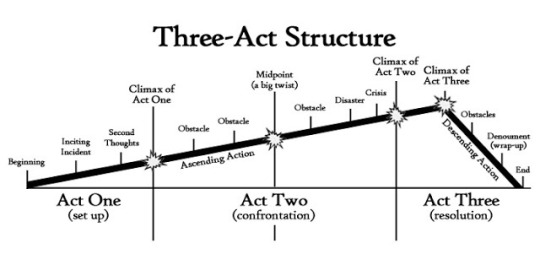
A three-act structure is constructed of just that, three acts, and roughly looks like this. Essentially, a beginning, a middle, and an end. Or the set up, the confrontation, and the resolution. These acts may vary in length, act two usually being the longest and act three usually being the shortest. But what truly defines them is the tension of each act, meaning what drives the conflict forward at that point. A story will have a main conflict yes, but that conflict will take on many forms depending on where we are in the story. Lindsey Ellis describes each act as consisting of multiple sequences, and defines each sequence by its individual tension as well. Though all points of tension should always stay related to the main conflict! So the main points we’re looking to identify in the story are the main act tensions and the main sequence tensions.
Let’s go through season one of Young Royals and talk about each story beat.
Act 1
Act tension - Wille has to attend Hillerska.
Sequence 1
We start with the Set up/Hook. The purpose here is to establish the world and the protagonist along with their internal conflict, such as their flaws and/or desire that makes them feel incomplete - The way Wilhelm’s character is introduced informs us that he is royal, but struggling with his role, because royals have set rules to follow.
“Why can’t I decide how the hell I want to live? I want to live a normal life!”
The thing that sets the story in motion is the point of attack. Something happens that is outside of the protagonist's control/knowledge - That would be the royal court deciding to send Wille to Hillerska without his permission. This gives the protagonist something to react to.
Sequence tension is established - Wille does not want to go to Hillerska. The rest of episode one reinforces Wille’s discomfort at the school.
Next, we get to the inciting incident. An event that disrupts the status quo, and our protagonist has to get involved - The initiation party, particularly when Wille and Simon almost kiss at the end. This leads him to acknowledge his attraction toward Simon and become more proactive in his pursuit of the boy.
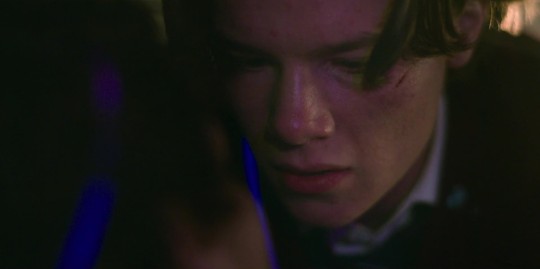
The sequence tension is resolved. Notice how in episode two, Hillerska is no longer the main focus for Wille, but Simon is. The seeds for what will become the central conflict have now been planted. The conflict is usually driven by character motivation. This is where we can consider the protagonist's Want vs Need. The want drives the main tension - Wille wants to be with Simon. But we’ll find want he needs later on in the story.
Sequence 2
The purpose here is to build up the creation of the main tension of the story. The main antagonist can also be established here - August keeps getting on Wille’s nerves. Especially when he’s trying to hang out with Simon.
That’s our sequence tension - Wille is working to befriend Simon, but August keeps getting in the way.
The end of the sequence sees the first major plot point, the Lock-in. Where our protagonist makes a decision that changes everything. Usually, something they can’t come back from - In Young Royals that would be the first kiss. Wille and Simon’s relationship has fundamentally changed. The main tension is now established.

Act 2
Act tension - Can Wille be with Simon, despite him being a prince?
Sequence 3
At the start of this sequence, the protagonist has most likely achieved some kind of milestone or learned something - He’s definitely like that.
To keep the story interesting, writers will add so-called pinch points in between the bigger plot points. These usually act as reminders of the antagonist or the pressure our protagonist may feel - Wille feels he needs to break it off with Simon because a prince is not supposed to be gay. As we established in the set up, royals have rules.
Sequence tension - Can Wille deny his feelings for Simon? Queer pining ensues.
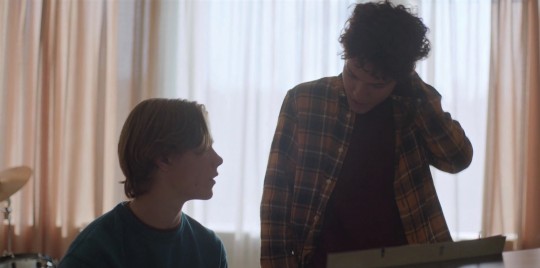
Sequence 4
The purpose of this sequence is to build up towards the midpoint. We see the protagonist making attempts to achieve their goal - The want never changed, Wille still wants to be with Simon, despite the pressure. Wille invites him to spend the weekend with him.
Sequence tension - Wille is trying to prioritise his new relationship with Simon, but August is still being annoying.
Then the midpoint hits. A major disruption, either from a character action or a force of nature. Can be positive or negative, just something that changes the aim of the quest without resolving the main tension - This time it’s literally halfway through the season. End of episode three, Erik dies and Wille becomes the crown prince. Everything has changed.
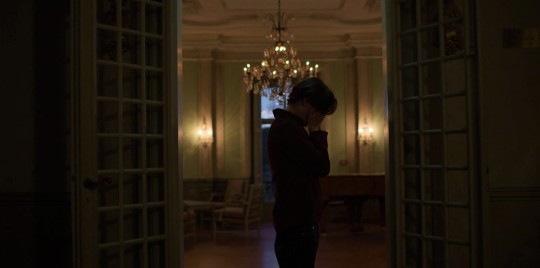
Sequence 5
Everybody has to adjust to the new world order after the midpoint disruption. We’ve reached another pinch point - Again we are reminded that royals have rules, and Wille makes another attempt to follow those rules. By embracing his new role, he breaks up with Simon once again, then sort of pursues Felice and joins the society.
Sequence tension - Wille adjusting to his new title while mourning his brother.
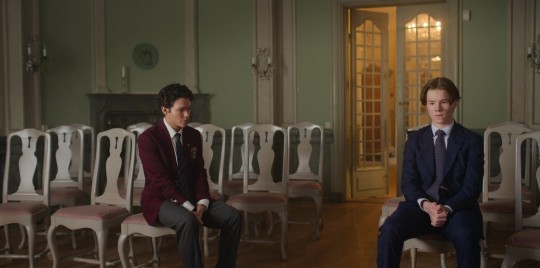
It’s common for subplots to advance around this time - Like Simon giving August the drugs to sell.
Sequence 6
Another plot point, where our protagonist may stop and reflect. Maybe have a heart-to-heart with another character, and perhaps make a decision - This is where we see the football field scene and the end of episode four. Wille reaches out to Simon for help, reconnecting with him. This leads them to pursue a relationship once again. They are put in a false sense of security. They are finally together, thinking all is good. BUT, we in the audience know that August has the video of them and the writers keep reminding us of him and the threat he poses. Even if Wille and Simon don't know it yet.
Sequence tension - Can this happiness last?
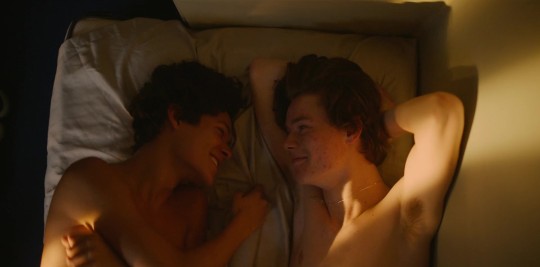
Sequence 7
(Here’s where the story leaves the classic structure for a bit, and adds an extra sequence for some more drama, as filler. In theory, they could have skipped this sequence and gone straight to the video being released. This part is mainly here to give motivation for August’s character, making his actions clearer)
So we are essentially given another pinch point, a reminder of antagonist or pressure - August tries to break them apart by telling Wille about the drugs, which leads to the music room fight.
Sequence tension - August is becoming more hostile.
Wille saving Simon from being framed for the drugs is more related to August’s money subplot. And the Lucia hug scene is mainly there for character building purposes. I’ll talk more about that stuff in part two.
The plot has advanced to the culmination of the main tension. The crisis that serves as build-up to act three - August releases the video. At the end of act two, the protagonist faces their biggest challenge yet. They’ve hit their lowest point - The aftermath of the video's release and Wille is totally lost.
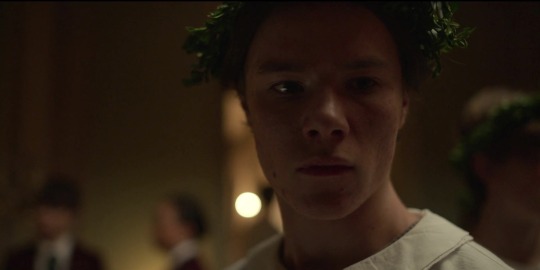
Act 3
Act tension - Can they save their relationship after the video?
Sequence 8
Begins with the protagonist making a big decision that creates the new act tension. The tension in act three will be different, but still related to the main conflict - Wille and Simon talk in the locker room, where Wille says he won’t do the statement.
Sequence tension - Can Wille avoid making the statement?
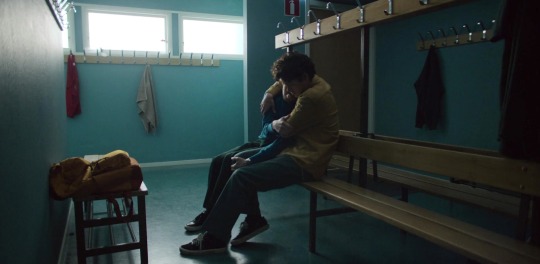
We’ve reached our last major plot point, located at the end of the sequence. Sometimes known as the twist in the third act - And what a twist, Wille does the statement anyway. This narrows down the tension further, to focus on a more character-driven intimate place for the next sequence.
Sequence 9
Sequence tension - Can they be together despite the statement?
Climax, the last big fight - Simon tells Wille off for being selfish and breaks up. Wille also finds out that both August and his mother betrayed him. The protagonist’s need has emerged from this journey and is now clear to us - Wille needs to decide who he wants to be. The want and the need should be different from each other, but still connected. Wille wants Simon, but in order for that to happen, Wille needs to break out of this cycle of self-preservation and stand up for himself against the royal court.
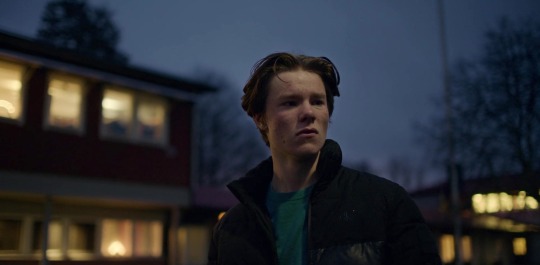
The climax will most likely lead to some kind of character growth - Wille is now pissed because he’s lost everything and realizes how corrupt the royal court is. As Lisa so beautifully put it, “A flame is ignited in him”. Hugging Simon in public is a display of his character growth.
And finally, Resolution. The point where the story is usually wrapped up neatly, but if left ignored, you get a cliffhanger - Which is exactly what happens in this season. Nothing is properly resolved at this point. Resulting in an open ending/cliffhanger.
Oof, that was a lot. How are we all doing? So these are the main beats of the plot. Makes sense? Let me know if you need any further clarification 😅 I was gonna get into how the rest of the show fits this format as well, but that’ll have to be in a separate post. Here’s part two!
#young royals#prince wilhelm#young royals analysis#young royals season 1#film theory#story structure#story analysis#young royals and the three act structure#wilmon#simon eriksson#august horn#my meta#my analysis
239 notes
·
View notes
Text
Changing Tides, Same Ocean - A Second Doctor Character Analysis
I don't think people give the 2nd Doctor enough credit for making the Doctor into the person we know them as today.
The 2nd Doctor is a true life enjoyer, living in the moment and (literally) approaching the world with child-like wonder.



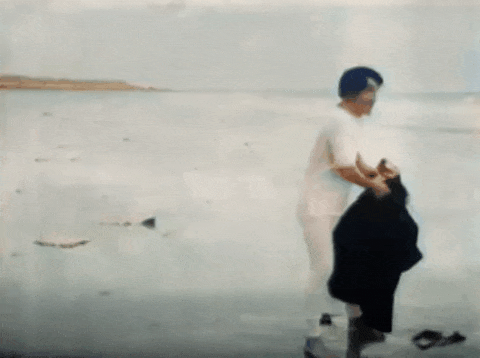
He's the first outwardly goofy Doctor and brought a stark contrast to the original, who was eccentric but overall well-mannered and less active because of his age.
The Doctor now has goofy props such as his iconic recorders, but is also known to carry thumbtacks and a sack of marbles. His clothes are also rather goofy, with his colourful suspenders, a coat that's too large for him and a bowtie that's clipped on with a safety pin.
But the aspect of him that really shines through in many of the following and NUwho Doctors, is his unmeasurable and honest kindness/compassion.

He isn't brave or strong, he often hides behind Jamie. He's often openly afraid and legs it if he can. He travels to see the beauty of the universe and isn't looking to find someone in need, But if he meets someone who's in trouble, scared or hurt, he always stays to help.

A lot of storylines of the 1st Doctor revolve around them landing somewhere and needing to get out of trouble. And because his companions are more able-bodied than he is, they are more often the driving force of the narrative... But the 2nd Doctor is able-bodied now too, and the narratives he finds himself in are often ones where, if the Doctor and his friends wanted to, they could turn around and leave again.
But they don't.
Despite being there to take in the sights, despite being scared and physically not strong, he stays to help anyways. Not because it's expected of him or someone pleads for him to stay, but because he genuinely believes it's the right thing to do. Which is a motive made all the more powerful with the scene below where he explains a bit about his culture.


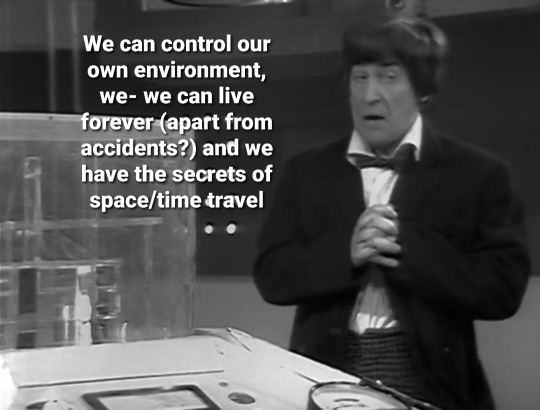


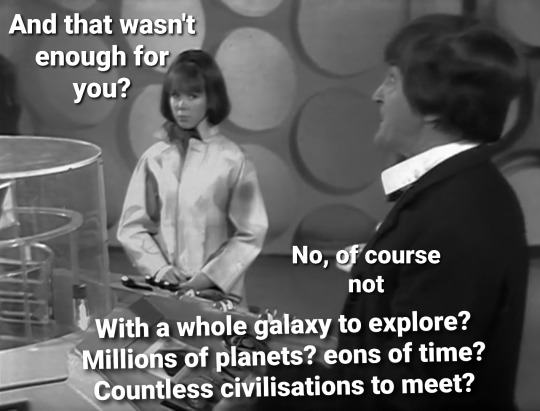
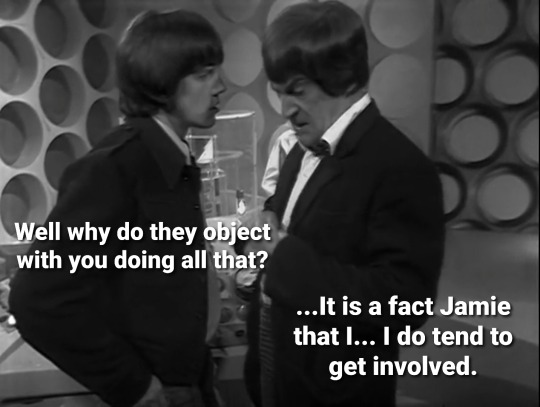
And the scene later where he's on trial for his actions and defends his motives with a powerful statement.

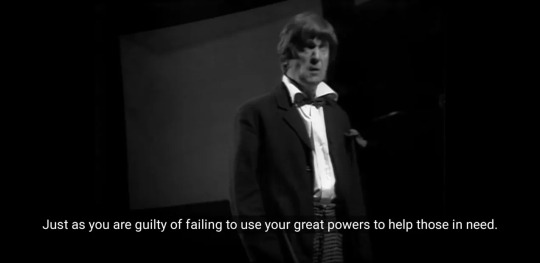
This is who the Doctor is. This is what it means to be the Doctor. And it's a sentiment we see returning over and over again.
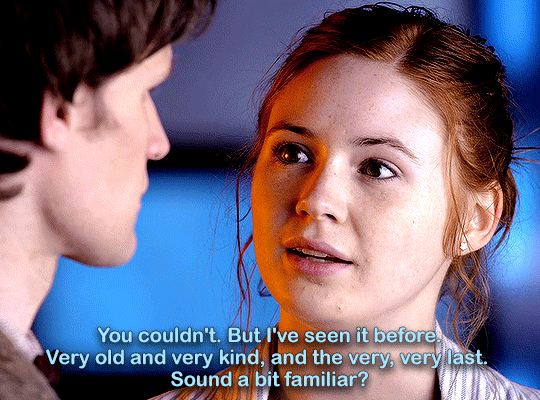


The character who hid behind another and ran at the very first sign of danger, the one who's only wish was to see the world, chose to die to save those around him.
And he hasn't changed ever since.
#doctor who#classic who#classic doctor who#the doctor#second doctor#2nd doctor#doctor who classic#the second doctor#talkies#character analysis#nuwho#nu who#new who#story analysis#analysis#long post#13th doctor#12th doctor#11th doctor#amy pond#jamie mccrimmon#zoe heriot#thirteenth doctor#twelfth doctor#eleventh doctor
64 notes
·
View notes
Text
Send help! I did too much story analysis and I dissected too many tropes and now I can predict what will happen in TV shows!
I used to be *surprised* and now I'm just like, "Oh, that was a good use of that familiar story structure! Excellent execution." And I'm still enjoying the same things, but like, I know why I enjoyed it? It's weird y'all.
107 notes
·
View notes
Text
Something about
"Saltburn being so heavily steeped with Shakespearean symbolism that the Midsummer Night's Dream party comes to serve as a meta commentary. A way to remind the audience that this is an intimate perspective of the character's lives, giving us a bit of a reprieve from the performative aspects of the film and the specific/stereotyped roles that the audience have unintentionally fashioned for the characters within their minds throughout the flow of the film. Eventually causing us to find them evolving into something completely eerily other but still so distinctly familiar when Felix's death strips away the comedically glistening veneer surrounding the Catton family and rendering them just as human, just as fragile and weak as anyone with lesser means in an almost uncomfortably satisfying and deeply perverse fashion that makes you want to look away but also keep watching and take a bit of a look at yourself in the mirror for relishing it-"
#foxglovevibes#saltburn#spoilers#saltburn spoilers#felix catton#shakespeare#oliver quick#farleigh start#venetia catton#elsbeth catton#character analysis#story analysis#film analysis
104 notes
·
View notes
Text
Hero vs villain: Jin and Hawks
So, the anime is here, and with it will most likely come the second phase of Hawks Discourse TM, but right now, I am much less interested in anyone's personal opinions on if what Hawks did is right, if twice deserved it, if this would be morally permissable if these characters were somehow real people, etc, and focus on what the NARRATIVE thinks of this fight. And in particular, the visual framing during it.
So, if you hadn't noticed, whatever you yourself think of this situation, the STORY thinks what Hawks did is wrong. Not the characters in the story (Though I must point out, Hawks himself calls Jin a good person even after he killed him and does not think he deserved to die) I mean the story as its own entity with themes and messages.
And the story is not on Hawks' side.
It undercuts Hawks' victory on several accounts. The most important one is giving Toga Jin's blood, effectively undoing Hawks' primary justification for killing him. He wanted to make sure the villains didn't have double, an immensely powerful and dangerous quirk, on their side? Well, too bad, they still do! Congratulations, you played yourself.
But that's the plot, the story's in-universe events making Hawks' actions have more negative effects than positive, thereby painting it as the wrong choice. What I actually want to talk about is framing, specifically the way the fight itself is drawn.
Because this?
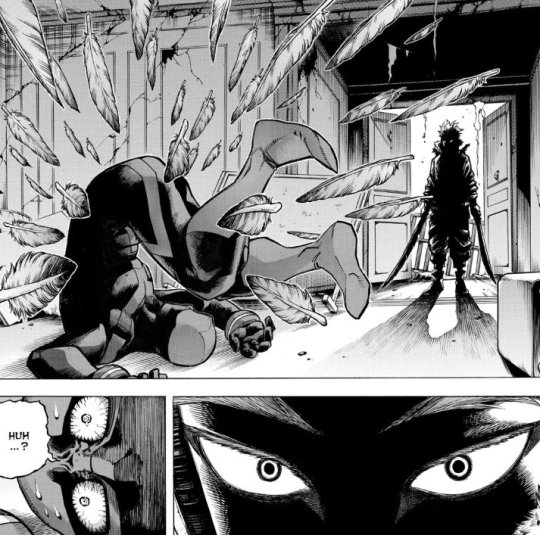
This is not how you draw a hero.
And interestingly, once you look at the Hawks vs twice fight in isolation- especially its first stretch before Dabi bursts in- without the larger context of the story behind it, it is drawn and written like a very classic hero vs villain fight where Hawks is the villain and Twice is the hero.
Let me tell you a story, it's probably one you've heard before.
Our Hero has recently made a new ally.
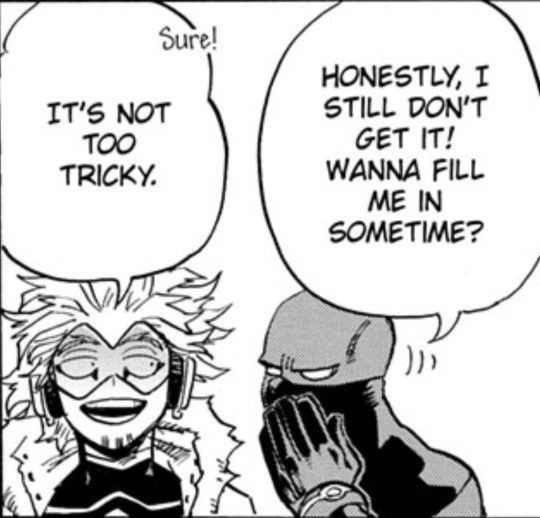
Some of their other allies are still wary of this new friend, because of their past loyalties, but our hero is trusting, perhaps too trusting for their own good. And the side this new ally used to belong to treated them badly! Our hero wants them to find happiness here.
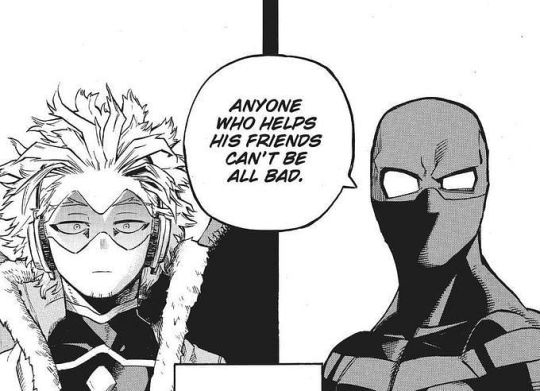
But then one day, there's an ambush. Their home is attacked, their allies and friends are pulled into a battle they're not prepared for, and this happens:

Their new ally has betrayed them. They never truly changed sides, and were feeding information to the opponent the entire time. They isolated the hero with a false promise, and when they got them alone they immediately put a weapon centimeters from their skin. Our hero hasn't even moved yet, doesn't understand what's going on, but they're already fractions of a second away from death.
The ally, turned villain, is framed in shadows, only their narrowed, almost glowing eyes are visible, as they stare unmoved and unflinching at the hero.
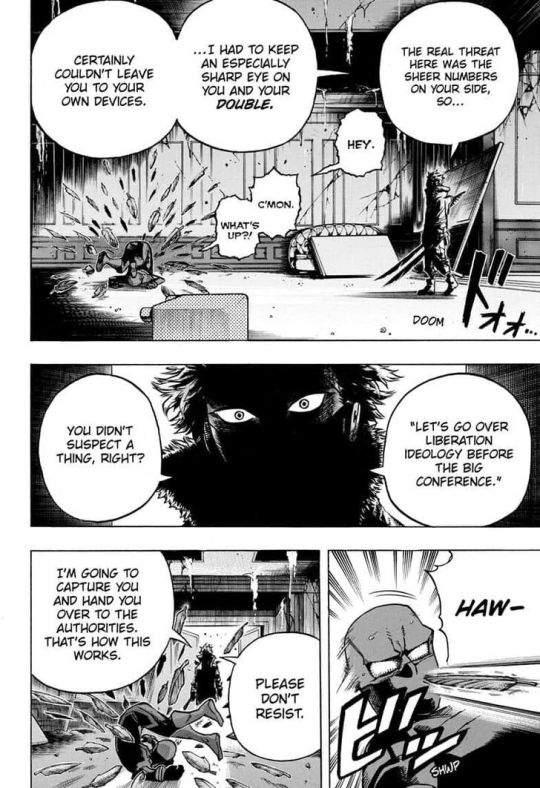
Our hero tries to plead, still hoping there's another explanation, but the villain doesn't let them speak. They monologue, monotonely, about what a threat the hero is to their side, how they had to be eliminated. They mock them for not figuring out the ruse, for being so trusting. They tell the hero to surrender.
And our Hero?

Thinks about their friends. About how their caring nature had gotten one of them killed before, and now it has brought them in danger again. They break down in tears. The villain's eyes watch from the darkness, silent and unaffected.

The villain looms over them, still shrouded in darkness, as the hero thinks back on another friend, a mentor figure. Someone that saved them when they needed it most, someone they went through hell to save in return not so long ago. They think back on what they said about trust, and they lament that they failed.
"Well, thanks" the villain says dismissively.
But then.
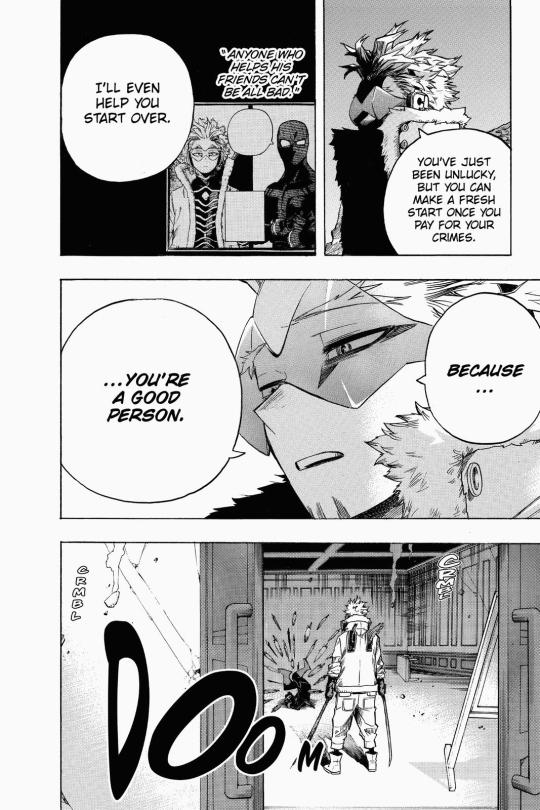
Some of the shadows that envelop the villain's face fade away, they think back on their real moments with camraderie with the hero.
Not even villains are immune to emotions. They don't dislike our hero, they don't necessarily want to hurt them specifically. In fact, why can't the hero join them? They could do so much together. (And this is classic villain monologue stuff, isn't it? Straight from the golden age of american superhero comics mha loves to pay homage to. Join the other side! And it’s always based on a fundamental misunderstanding of the hero that the villain just can’t grasp, which is.. exactly what happens between jin and keigo.)
The next panel pulls away, and the rumbling outside reminds us, the readers, exactly why the hero can't.
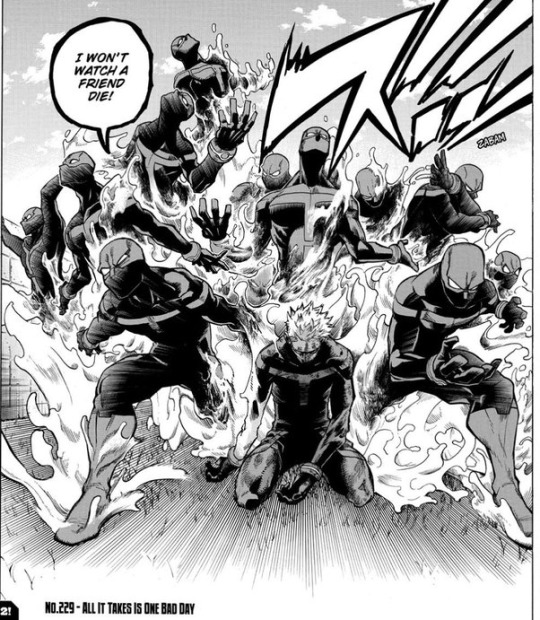
Their friends. Who are still out there, possibly being slaughtered by the villain's side. Friends are everything to our hero, they can't just abandon them. (And this is that misunderstanding. Hawks thinks twic eis the only oen in the league who is capable fo being saved. But you can’t save Jin if you can’t save the league. I won’t get into it here but this is why izuku, shouto, ochako and their respective villains are so important)
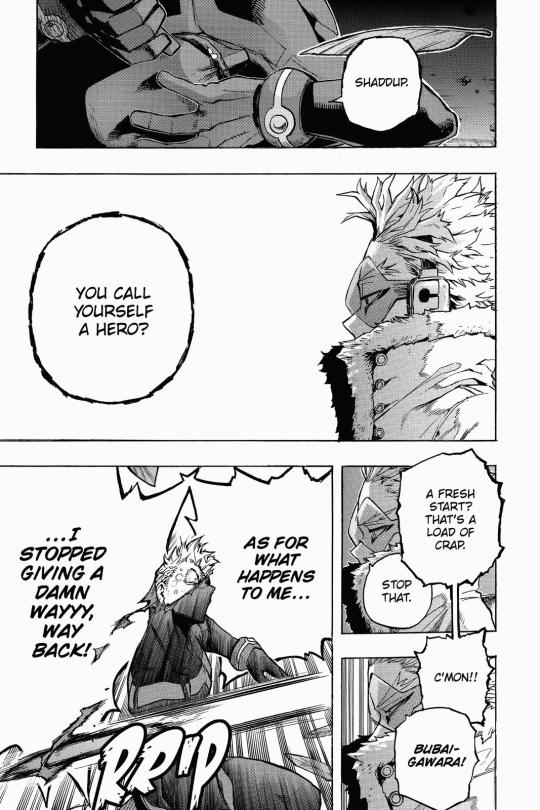
So the hero refuses.
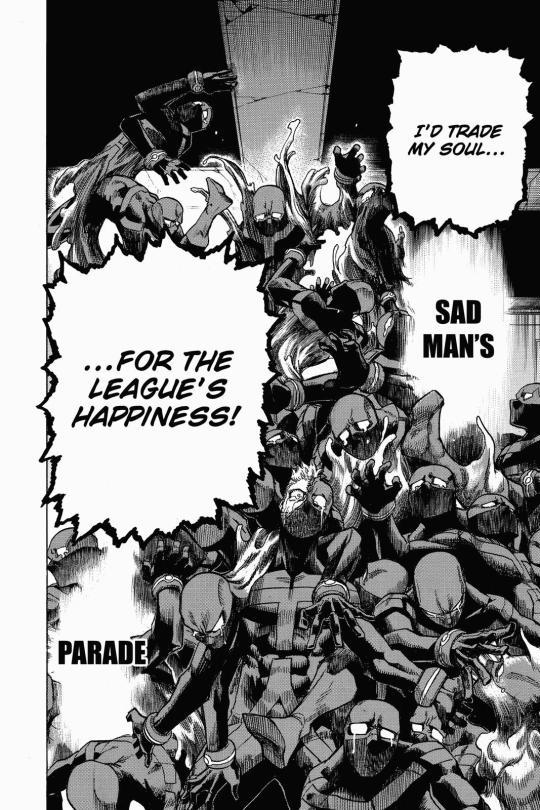
It’s of note here what exactly our two sides look like going into this battle. One is crying, in pain and betrayal, ready to sacrifice their life if it give their friends a chance at safety.
The other?

Resigned. Eyes narrowed. Weapons ready to strike. Not showing any emotion on purpose because showing emotion is showing weakness.
And that unevenness, that contrast, persists throughout the fight. Our villains does not move a single inch as they slaughter a dozen clones of their former friend apart. Everything on the page moving, desperate, violent, except for them. They comment on our hero’s skill dryly, not even out of breath.

Generally as readers we sympathise with effort and like conviction, and repression of emotion is seen as a negative trait. Such an obvious difference in visible effort (No doubt thawks is ACTULLY putting in a lot of work to get his feathers to be so fast and precise, this can’t be easy for him. But it LOOKS easy) also creates an underdog narrative, and we tend to naturally root for the underdog.
And then comes the line that sums up this entire fight:

“I could never allow mere sentiment to trip me up,”
Because ultimately, this is not just a fight between two people. It is a fight between human connection and duty. It is a fight between someone who refuses to hurt the ones they love and someone who will. Who is, in fact, doing so right now. Our hero fights because they refuse to give up on people, our villain fights because they already have.
And if you wanted it to be any more obvious, here are the physical manifestations of all our hero’s friends, being mercilessly sliced apart! How’s that for heavyhanded symbolism? Though, really, if you come to a superhero comic for subtlety, you might as well go to the beach to wash out the sand in your clothes.

So we’ve been looking at this fight ignoring the context, that the hero in this scenario is not twice. He is the villain of this story, even if he is not the villain of this story within that story.
For this next page, that context will come crashing back in. So I want to ask you to read these lines while mentally erasing the word “villain” and “hero” from your mind.
What do they sound like now?

“Why do you think I prioritize speed when taking my enemies down? Because it’s the ones who don’t give up that I fear the most.”
In not just superhero comics at large, but the shounen action genre specifically, tenacity, hardheadedness, and never giving up on one’s friends are the classic traits of a protagonist. They’re basically staples of the genre. (Hell, deku, the actual protagonist of this very manga, fits into that mold perfectly) Speaking outright of fearing and hating those who never give up, who have genuine conviction they are willing to die for, is something so classically villainous i’d call it cheesy if it was played straight. That’s cartoon villain shit.
Our hero has no time for this speech either, they start to say “Shut-”

-”Up.”
They don’t even get to finish their sentence.
The shadows are back. Notably, our hero is all dressed in black, but their face is illuminated. While the villain’s clothes are all drawn in light colours, but their face is hidden in darkness. Some very nice traditional color symbolism here.
And what are our heroes last words as they face their imminent death?

Their friends, especially the little girl they’ve grown closest too these past months. They know the villain doesn’t care, but it’s more like a need when they tell them that this girl they dismissed is kind, that she took care of them. This girl, that the world can see only a monster in, they have to affirm, even to a person who won’t listen, that she’s good. That she deserves to have someone be willing to die to protect her.
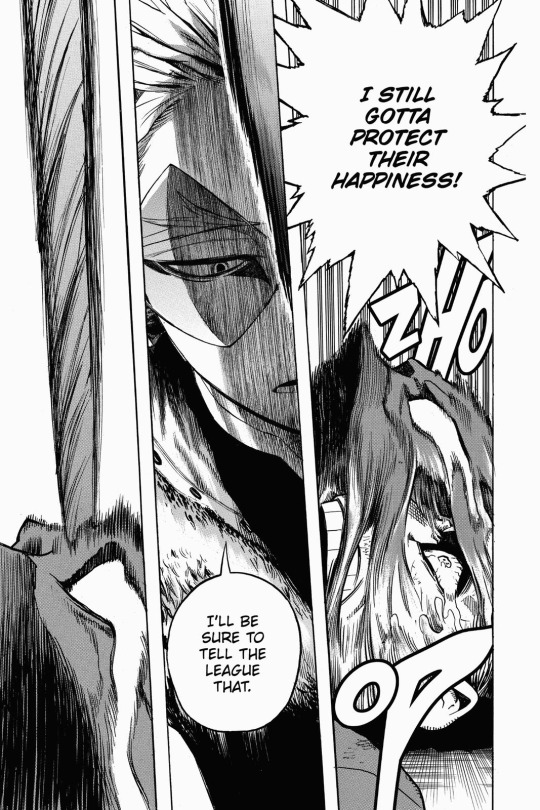
“I’ll be sure to tell the league that.”
Is it mockery? genuine? Do they even care enough about anyone else in the league to bother to follow through, or is this just a casual dismissal?
It doesn’t matter.

They don’t have to.
And if this were one of those classic superhero stories, or an early more traditional shounen, then the arrival of this friend would have spelled the end for the villain. This whole fight has been about he power of human connection in the face of cold and uncaring order. And what better way to end it than by having the hero’s friend prove him right? Especially the one who’s been rude and distant this entire time, who was the other one to bring this ally-turned-enemy into their ranks, who’s been constantly denying that their friends are even their friends to begin with? But they came, in this moment, and that’s what matters.
But this is not a classic story. Twice is not our hero. And this friendship does not save the day.
It ends with a high five

And a stab in the back.
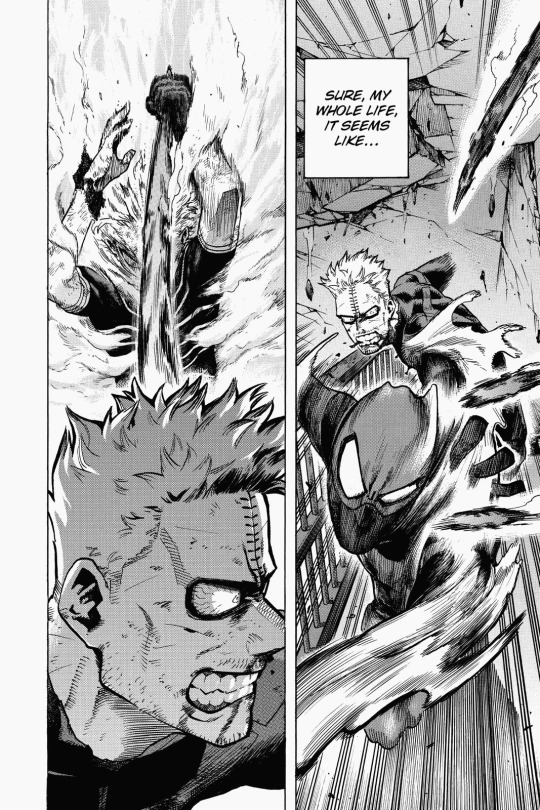
And a girl’s smile fading.


And, no matter what you think of this fight in context, EVERYTHING on the actual pages of the manga depicting the fight itself is trying to tell you that Hawks is doing the wrong thing. That Twice- regardless of his overall morality- is RIGHT to stand by his friends and not give up on them. Even if those friends are villains. Even if he is also a villain. According to the story, Hawks is wrong, and Twice is right.
#bnha#bnha spoilers#bnha season 6#twice#bubaigawara jin#hawks#takami keigo#bnha meta#story analysis#please don't think i hate hawks because of this he is my blorbo despite the atrocities he's comitted <3#i emphasize a lot on how unmoved he looks by everything which is of course because he's so used to repressing his emotions#but out of context and therefore to jin it just looks like he doesn't care#which is another great way this fight plays with tropes#it MAKES him look more uncaring and villainous#which is the whole point#that the corrupt system has made this hero indistinguishable from a villain
626 notes
·
View notes
Text
Jason has had lot of people violating his bodily autonomy lately
Task Force Z injecting him with lazarus resin after he'd told them to keep that shit away from him
Bruce drugging him and using a machine to give him debilitating fear when his adrenaline spikes
One of the Jokers spraying joker gas in his face
#dc#dc comics#comics#comic books#task force z#gotham war#the gotham war#joker the man who stopped laughing#jason todd#red hood#media analysis#story analysis#parallels#media commentary#matthew rosenberg#chip zdarsky#tini howard#bruce wayne#batman#amelia and delia#the joker#lazarus pit#batman comics#catwoman comics#themes
98 notes
·
View notes
Text
The Good and the Bad Ending.
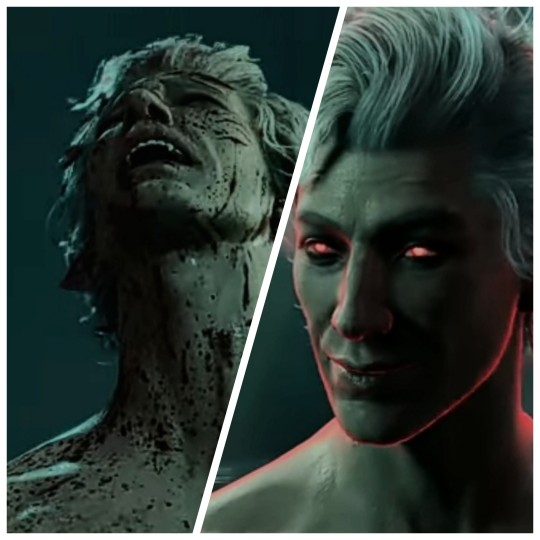
This is a purely analytical look at Astarion's story, considering both endings.
I am drawing on my knowledge, which I gained through studying creative writing and years of passion for stories and characters. I will not be making any judgments about whether ending is "right" or "wrong." Each individual can decide for themselves which one they prefer. (Forgive errors in the text, English is not my native language)
At first, I will explain to you some tools to plan or analyze a story. A schema that can be used to orient yourself to roughly plan a story. To prevent having just a narrative of events, but to use exciting plot points to turn a narrative into a story.
The most famous is the three-act structure. Sound familiar? The three acts in Baldur's Gate.
Very roughly: Beginning - Middle - End.
The impetus - the emotional climax - the test of strength.
Then there is the five-act structure and some triangles. Everyone can use their favorite there. I orient myself on the so-called hero's journey, it uses between 12 and 17 points. The individual sections can be interpreted creatively and weighted individually.
With "hero" here, no knight or superhero is meant. He doesn't even have to perform heroic deeds. A hero is here referred to as the protagonist, i.e. the figure that it's about. The journey is, well, the journey. Of course not from London to Thailand, but the events that shape the figure on her way.
Astarion's Story Based on the Hero's Journey
1. Everyday life
We learn about the ordinary life of the hero. It doesn't have to be shown exactly how he lives, like in Harry Potter. It can also be mentioned in the course of the first events, as long as it happens in the first act. And in the ordinary world, there is a problem, from which the goal of the protagonist emerges. Every story needs a goal. Without a goal, no journey.
We learn that Astarion's daily life consists of luring victims for Cazador, mostly on a sexual basis. Torture, hunger, fear, and the complete abandonment of his personality form the problem. The goal is therefore freedom from his master Cazador.
2. Call to Adventure
The hero is usually thrown into an event that represents a significant change in everyday life and challenges him to address his problem.
Astarion is kidnapped by the Nautiloid and given a tedpole what makes possible for him to live a life of freedom now. (walking in The sun... You know) He does not have to fear his master anymore.
The hero usually resists the adventure first, but there comes a point where he finally decides. (Like in the Matrix: the red or the blue pill? )

From Astarion's origin, we know that he dreams of Cazador, who reminds him of his rules. Astarion decides to break one of these rules and bites Tav. After the bite he feels stronger because he has drunk the blood of a thinking creature for the first time, something his master forbade to keep them weak. he now feels ready to take on the adventure.
The next 3 points relate to:
3.4.5. Building Up the Conflict
We usually meet a mentor here who enables the hero to embark on his journey, who supports him and gives him advice. For Tav, it is The Guardian, but we are looking at Astarion's journey, and there is definitely Tav, the companion who supports him and guides him in dialogues (which one to support decides the player)
We learn about a so-called gatekeeper. Something or someone that makes his journey difficult, which is either identical to the mentor or to the antagonist.
This could be the scars on Astarion's back, which symbolize the influence of Cazador. Something seems to be still in his way, but what do they mean?
6. Crossing the Threshold
Symbolically, as well as actually, the hero enters unknown territory. The shadow curse.
Symbolically, Astarion begins to question things and explore unknown territory. He touches the scars because he now wants to know what is written there, as he feels that it has relevance.
he even seeks the help of a devil to find out more about the scars. Astarion is so afraid of being Cazador's slave again that he would rather give his soul to the devil, he says.

He is concerned with maintaining his freedom and how he could defeat Cazador. A thought that seemed impossible before.
He wonders how he can become even more powerful with the help of the tedpole, so as never to get into this situation again?
In Astarion's worldview, the powerful are the ones who oppress others. This means for him that in order to never be oppressed again, he must be mean to others. So he is manipulativ and selfish. This worldview is reflected in his approvals.
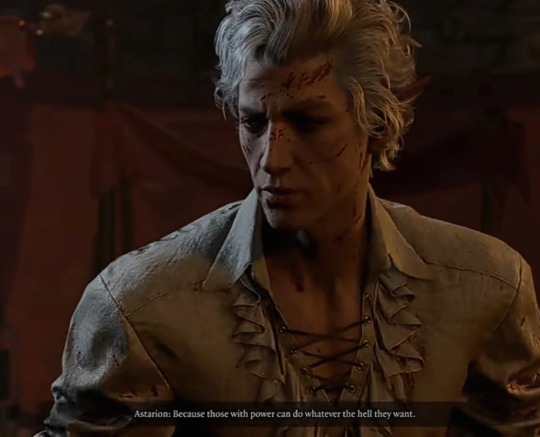
Now, when he is essentially already free, he also begins to question himself. An example of this is the mirror scene. What was his eye color like before? How does the world see him? How does Tav see him? Who is he behind the vampirism?
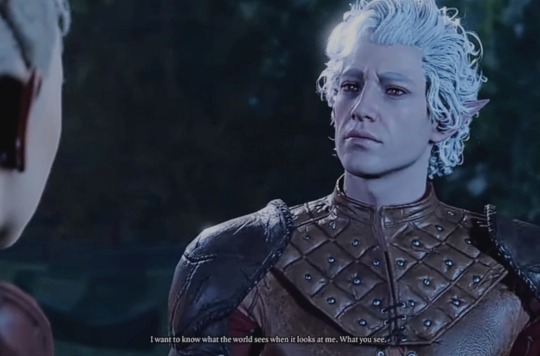
7. Road of Trials
The hero learns what rules and laws he still needs to learn in order to face his ordeal (Cazador). Here, the so-called ('fall height') the drop high, is usually represented. So how much could the hero lose if he fails?
This is where the meaning of the scars becomes important. In this case, his death and not only that. After this ritual, his soul goes to Mephistopheles.
8. Death and Rebirth
The hero dies a symbolic death and after this event he is changed. In Shadowheart, it is clearly the moment when she faces Nightsong. For La'zel, it is questioning her queen. After that, they have a different view of things. They are changed, Shadowheart even physically. This change is called initiation (more on that later)
It doesn't always have to be a fight, it can also be the death of a friend, or the hero learns about his true origins.
characteristic is that the hero is changed.
In order to get an answer to the meaning of his scars, he is supposed to kill the Orthon for Raphael.
9. Initiation
The moment of the symbolic death of the old and the birth of a new, more mature identity is called initiation.
For me, this is clearly the confession scene. In my opinion, it is the most important scene. The turning point of his character. It definitely takes place after the fight with the Orthon and as soon as you reach the Moonrise Towers.
Here we see the real Astarion, who has taken off his mask. He is honest and sincere and accepts the consequences consciously, since he really regrets his behavior towards Tav. Not manipulativ or selfish anymore.

This scene is also triggered after the dialogue with Araj Oblodra. After he clearly states that he will not bite her. But what exactly happens there?
He was able to decide for himself for the first time in 200 years, to resist, without having to fear anything. He realized that he was already free in his choice of actions, but still stuck in old patterns. He questions himself. Who is he if he is no longer Cazador's slave?

He is now honest and confesses to Tav about his manipulation and his sexual trauma. (Which is a moment of weakness and Astarion generally does not like to show weakness.) He begins to take responsibility for his actions, the character begins to change.
10. The Gift
For the previously aroused courage, the hero receives a reward. A gift. This can be a skill, a weapon, knowledge or an insight.
For killing the Orthon, he now gains the insight into the meaning of the scars and learns a way to become the Magnificat bastard of Fearun himself.
With his honesty and confession, he has won Tav over to his cause. He has shown Tav his true self and Tav will (at best) fight for him without having to give up his body as usual. So the friendship/romance with Tav is a gift too.
11. The Escape
The hero has to return to everyday life because the forces of evil are still active. Here the hero meets old ghosts and meets them with his changed self.
In the catacombs of the palace of Szarr, Astarion learns that all his victims of the past 200 years were hidden there to be sacrificed for the ritual. Especially the encounter with Sebastian seems to trigger something in him and mirrors the relationship to Tav, where he was able to allow feelings. Here Astarion seems torn, he jumps from absolute disinterest to sincere remorse. Which is a sign of mental instability. Astarion shows many symptoms of ptsd, but that is material for another analysis.
12. Final Ordeal 1
The most difficult part of the journey now lies in the final ordeal. Here the hero applies his new insights and gifts. He knows about the ritual and how he could stop it or use it for himself. He has found enough self-confidence to attack Cazador, but of course it is not that easy. Alone, his soul would be in hell within a few seconds. The fight begins and now his previous achievements pay off and Tav helps him.
13. Final Ordeal 2
The hero believes he has accomplished the task, but he realizes that he still has a task ahead of him.
(Ascension or Not?) Because the forces of evil are still active and he has to fight for the gift again.

Now he sees the power and is faced with a decision.
We remember, everything he does, he does out of fear. He would even give his soul to the devil, but is that still necessary when Cazador is dead?
And here Tav comes into play. the mentor who helps him make the right decision based on previous dialogues and actions.
-You decide, based on your Playthrough-
Important: The best stories always make the hero pay a price to achieve his goal. Otherwise, it seems too easy and the reader is not emotionally drawn in.
So what price does Astarion pay?
The Bad Ending
It is called bad, as it continues the cycle of evil. Astarion sacrifices 7,000 souls to satisfy his need. He continues what his master started. The villain has only changed his face.
If Tav doesn't make him feel like he's enough (the level of approval) that he don't need that infernal contract his Master started. Then he doesn't feel safe enough to stop the ritual.
After the ritual, he is free from the flaws he had as a vampire
The Price
His soul? Maybe. Cazador says that all who wear this rune are bound to the ritual and will be consumend.

This ritual has its rules, something has been changed, the one who performs it, but does it change the rules?
Even if not, this ritual is infernal, and it is often mentioned in the game that a pact with the devil always comes with a price. Wyll says that the devil doesn't just take something, he takes everything.
The ritual overrides the process of self-discovery and the mask of madness that grew out of the trauma has manifested itself.
'Your hunger veers towards madness' is what it says in the Origin. And this madness is immediately noticeable. He goes back to his old patterns. His striving for power, as we know, a sign of fear, and seems consolidated. He doesn't talk about anything other than ruling over everyone. He is performing again, especially in the romance that becomes visible when he asks you how you would like it. He is obsessed with you, which is a sign of fear of loss. He remains a slave to his trauma.
The Good Ending
It is 'good' because the hero defeats evil, interrupts the ritual, and frees 7,000 spawns.

Astarion understands that he can break the cycle of evil, who he was being a victim himself and giving up the power so he will not sacrifice others to satisfy his needs.
We remember the confession scene. The character has changed and is sticking to it. He is sincere and accepts the consequences consciously, since he truly regrets his past (for example what he do to Sebastian)
Astarion has no longer to perform in front of anyone and can therefore deal openly with his trauma. In the Romance scene he processes what happened to him and is now ready to face his own future.
The Price
He gives up his wish to regain the comforts of a living being to not sacrifice 7,000 innocent people he lured. He cannot have the comforts of a living being again. He is once again a slave to his hunger and the shadows. He gives up the ability to walk in the sun, as soon as the tadpole disappears.
Conclusion:
Let's look again at the goal and whether it was achieved.
In both endings, he is free from Cazador.
So the hero has achieved his goal, both endings are meaningful for Astarion.
One is morally right, the other morally wrong. It is up to the player to decide which one is better.
Can power help to deal with a trauma if you continues the cycle of evil u lived in?
Do you have to live with the disadvantages that someone else has given you?
Astarion himself approves to be persuaded not to ascend. +3
#creative writing#baldurs gate 3#astarion#astarion bg3#baldur’s gate 3#dnd character#story analysis#charakter analysis#bg3#ascended astarion#spawn astarion
67 notes
·
View notes
Text
Prime Defenders has such good villains, and I think part of the reason they're so effective is because for many of them, it puts a lot on how the players react and what choices they make
First with Wavelength, there's the struggle of "how much do we work with this guy, if at all, where do we draw the line" which causes so much tension, and then you throw Ashe into the mix and add yet another set of questions and layers.
There's Mallard Conway, who's clearly evil, but the help he offers seems real. The power he offers seems real, but he always leaves you suspicious of how much of it is Will's or his.
Then you have the Trickster, who's brilliantly acted and I'm never getting over that, but Bizly also does such a great job making him seem like an impossible enemy. He wears the face and sometimes voice of their friend, has insane powers, and often throws a dangerous problem at them and dips, leaving them torn on what to focus on: deal with the problem first? Follow the Trickster? If they find him, should they treat him as just an enemy or is Ashe still in there?
And then there's David Bell, the bastard himself. He's so fucking nonchalant about horrible things and pulls the mob boss "my hands are clean, it's all other people doing the dirty stuff. I tell them to take care of it, not my problem how they do it." He's a manipulator, but in such a way that's so... low-key? I don't know how to describe it, but it just seems like he's arguing his point of view like anyone else and seems almost reasonable, and then you look back and realize he fucked you over completely.
#prime defenders spoilers#jrwi spoilers#jrwi prime defenders#jrwi pd#just roll with it#jrwi show#fuckin well done bizly#pd villains are so good#prime defenders#story analysis#character analysis#villain analysis
105 notes
·
View notes
Text
Why Namor x Shuri makes sense in terms of story structure
So if we go off context, Nashuri was already planned by the writers, as seen in interviews and the og script. Which isn't surprising because viewers picked up on their chemistry and romantic undertones in the movie already. The only reason this was changed is because they wanted to focus on the theme of grief and dealing with loss. Which has been the main theme for phase 4 in general since we're moving on to new heroes.
Also not sure if people are aware of this but the choice to kill Ramonda was more or less a last minute decision by Ryan. Angela only agreed to it after Ryan brought up how often it is for characters to come back.
So this could mean Ramonda's coming back to life or will continue to make appearances. If she does come back to life this more or less weakens the "but he killed her mom!" Argument.
Now let's talk about Shuri's story and Namor's role in it. Because at the end of the day this is Shuri's story.
Shuri's story in WF is her journey from childhood to adulthood. Tenoch has said this is his favorite thing about her story.
In the beginning she is a girl by the end she is a woman.
The particular kind of story structure Ryan used is called "The Heroine's Journey" a popular method to use in storytelling with female leads.
You'll find similar stories following this method in movies like "Star Wars, Labyrinth, The Hunger Games, The Wizard of Oz etc."
"The Heroine's Journey" is a female version of "The Hero's Journey" which is used for male leads. T'Challa actually goes through his hero's journey during "Civil War" and "BP" so im not suprised Ryan used the female version for his sister.
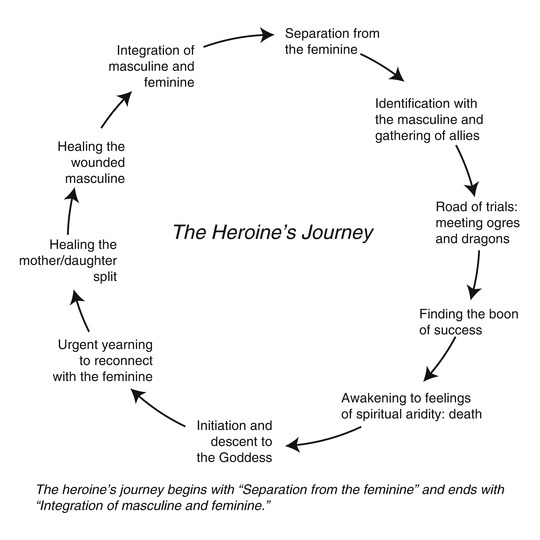
If you look at the structure of the heroine's journey Shuri pretty much hits all of these.
Distancing herself from her mother, venturing out of Wakanda (both in America and in Talokan) aka leaving the nest, and having her time to shine.
Both the hero and heroine's journies are a method to mature your lead in a way that makes sense and is relatable since hey, we all gotta grow up some times.
Also a subtle thing Ryan incorporated was how both Ramonda and Okoye treat Shuri like she's a child while Namor treats her like an adult, because she is.
Now something that is not always included but is common in both, is the hero or heroine's being presented with sexual incitement, at times for the first time. This signifies them coming into sexual maturity which is why you won't see it in every story or may just get subtle hits of it.
Now if it wasn't obvious Namor is ment to be Shuri's expirence with sexual enticement. Possibly her first encounter since we don't know her history.
And this isn't a "maybe" situation he literally just is. Firstly, this role usually is presented when the hero leaves the nest, not to mention Namor takes up every single trope of this role.
-Invades the hero's space (hut scene)
-whispers to them (again hut scene)
-touches or caresses them (First holding her hand then putting his mother's bracelet on her)
-shows them something new and exciting (Talokan)
-Is usually older then the hero (20s vs 500)
-Often times wears clothing that is either tight fitted or very little clothing (bro is literally walking around in nothing but jewelry and booty shorts)
Secondly, sometimes you'll straight up get subtle hints and/or introductions of sex it's self.
-In Star Wars there's a scene where Leia has to sit on Han's lap and the ship starts bouncing up and down...
-Again, in Star Wars Kylo Ren wipes his mouth which we see has water on it after meeting with Rey through the force...
-With Shuri in Namor, their fight has a weird amount of grappling and holding, not to mention the back scratching...
Namor treats and speaks to Shuri like she's a grown woman. He doesn't handle her with kid gloves like everyone else, he respects her as an adult who can make her own decisions.
In a dark sense even when it comes to either raging war after Ramonda's death or the alliance. He leaves it up to her to decide.
Also Riri, just isn't this to Shuri. This is not to say people can't ship it cause you can ship whatever you want, their all fictional. But Shuri refers to Riri as "a kid", "a child" or "a girl" depending on what translations you watch. This is to show the audience that Shuri does not view Riri as an adult. They're confirmed to have a sisterly bond. Shuri lost a sibling and gained a sibling.
But back to Namor, he also is noticeably kinder to her then he is to literally anyone else in the movie besides his people. Not to mention it's canon that he finds her charming and interesting. He also likes her smile.
It's confirmed by Ryan that he never wanted to kill her even during their fight which some fans noticed, he never tries to kill her even when he has an obvious chance.
And lastly, he sees Shuri as an equal by the end of the movie, showing he has respect for her as a protector of her nation and possibly even views her as a god now but we have to wait and see on that one.
As quoted by Ryan, Namor is ment to be a Peter Pan archetype and when you think about it he really is. He's black and white way of thinking is very childish, he's incredible stubborn, he's arrogant and cocky, yet at the same time, curious and charming. Like Peter he's a father to his people (he literally refers to them as his children) and their sole protector.
There's innocence to his character that's very compelling and shows how young he is in mind.
-he collects (maybe steals, very Killmonger of him) Mayan artifacts from the surface since he never got to see Ancient Maya.
-speaking of collecting things, he even collects random surface world stuff. He has 2 gramophones in his hut, which he most likely got from a ship back in the day.
-he's suprised and charmed by Shuri's kindness. Which makes session since she's the first surface person he's ever spent time with.
-and hey, he got his love of drawing from his mama.
Now what does all this mean for Namor and Shuri in the future? Well for one you got a good amount of back up for them no longer being enemies.
1. Shuri's heroine's journey is over now.
2. Namor was the one who forced her into womanhood.
3. We concluded the story at her finalizing her grief
4. It's canon that Namor was humbled by Shuri after their fight.
5. Wakanda and Talokan will be working with each other.
6. Namor may play a mentor like role with Shuri
7. Dispite many romance scenes being removed they still chose to keep enough hints for people to pick up on.
8. Their fight is described as "intimate" by both writers.
9. Namor and Shuri are described as "two sides of the same coin" and "twin flames" (these are the same descriptions that were used for Rey and Ben Solo in Star Wars)
Why does them having a possible relationship make sense? Well the most basic answer? They're the only two people that can understand what the other is going through.
Their both protectors of great nations that are centered around a resource unique to their land and have a culture and ancestry untouched by colonization. They both know grief of losing people they love. (Namor's mother and his two handmaids, Shuri's brother and mother) Their both EXTREMELY intelligent. (Namor build a vibranium sun underwater and I don't remember where I read it but he learned English in a week.) They both find each other interesting. They both see each other as equals. They both have alot of growing to do.
So will they have some kind of relationship? Most likely. Will it be romantic or platonic? Who knows. But we know they won't be enemies so we have to wait and see.
#namor#shuri#shuri udaku#namor meta#shuri meta#wakanda forever meta#wakanda forever#black panther wakanda forever#black panther#nashuri#namuri#story analysis#heroine's journey
211 notes
·
View notes
Text
oough thinking about the way the director specified COMMON children not just children when todd and ambrosius were arguing
(amb not getting a childhood because of his 'royal line' status, other knights also being pushed to be the best they could, possible grievances full grown adults had on amb because their children would 'never be as good as him', amb feeling outcasted because he was 'different' from the other outright children in their knight courses, amb not knowing how to deal with kids as an adult because he had to grow up as soon as he could raise a sword, amb having accidental prejudiced thoughts about ballister and how he 'must' be just like the stereotypes he grew up on when they met first, amb-)
#im back baby (i got told i should be in a way higher art-talk type thing over me overanalyzing a picture of a shitty bird dad)#nimona ambrosius#nimona movie#nimona#nimona film#nimona netflix#ambrosius goldenloin#ballister x ambrosius#ambrosius x ballister#goldenheart#dialog analysis#character analysis#story analysis
75 notes
·
View notes
Text
Houseki no Kuni Chapter 107 Thoughts: Goodnight, Sweet Phos...
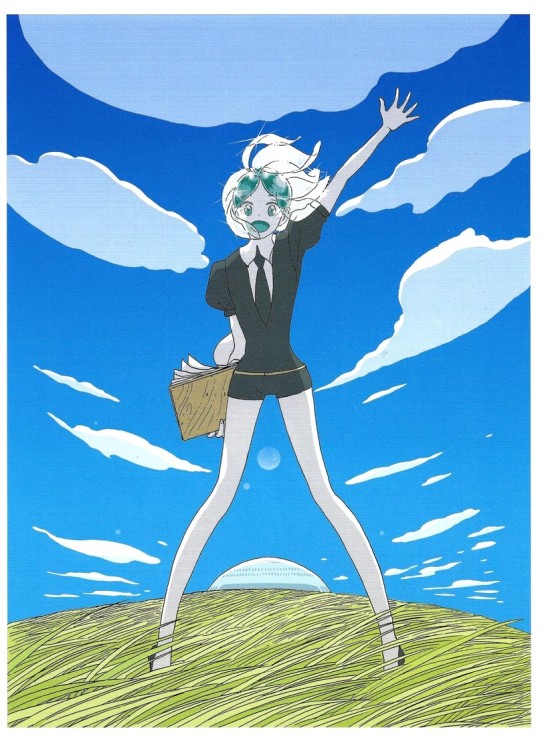
Hello everyone! Sorry for the delay with this post. I originally intended to finish it and post it on Wednesday, but you know.... life happened.
Another month has gone by and now we're on our second to last chapter for Houseki no Kuni. That's right; it's been confirmed that the next chapter will be the last chapter. Can you believe it? If you've seen my previous posts, I'm sure you have an idea of how I feel about this news.
But that'll be for the end of this post. For now, let's talk about this chapter! I don't know how long this one will be, but I'll still warn you that it might be longer than intended, which is the norm for me. This post is a bit too messy for my liking so I might end up making some edits to it later. For now, I just want to have it posted.
As always, please feel free to share your own thoughts in this post! Here we go!
Visual Storytelling Through Change in Style
The first thing I want to talk about is the visuals for this chapter. It greatly contrast with the visual style of the previous couple of chapters. In those chapters, the art was loud, intense, and chaotic, and yet mesmerizing and immersive. The heavy use of black, sharp lines and patterns emphasizes on the harshness of the changing environment. And in many of those page, Phos looks so small, as they are literally being consumed by their surroundings. Even though there were many panels where Phos, Eyeball, or the pebbles are the focus, the background is still very overwhelming in comparison.
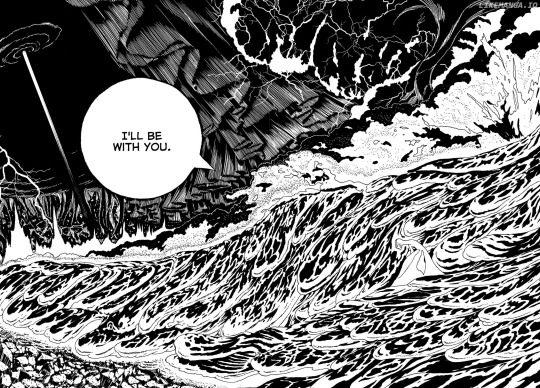
Now contrast that with most of the visuals in this chapter. Most, if not all, of the intense visual motifs from the previous chapters are gone; no sharp patterns, black is subdued significantly, and the background isn't overpowering the characters.
The intensity of the visuals were cut back significantly and were traded in for simplified line art, heavy use of the white negative space, and soft hues that make everything airy and dream-like. This is especially true during Phos's sequence. I like how there are very few thick continuous lines in the artwork. These illustrations are mostly made up of light, loose broken up short lines that create abstract structures. And I like that as the regression continued, Phos's design simplified to the point that they were just a small abstract face.
This art style literally and metaphorically showed us the deconstruction of Phos. It's so simple, and yet so impactful.
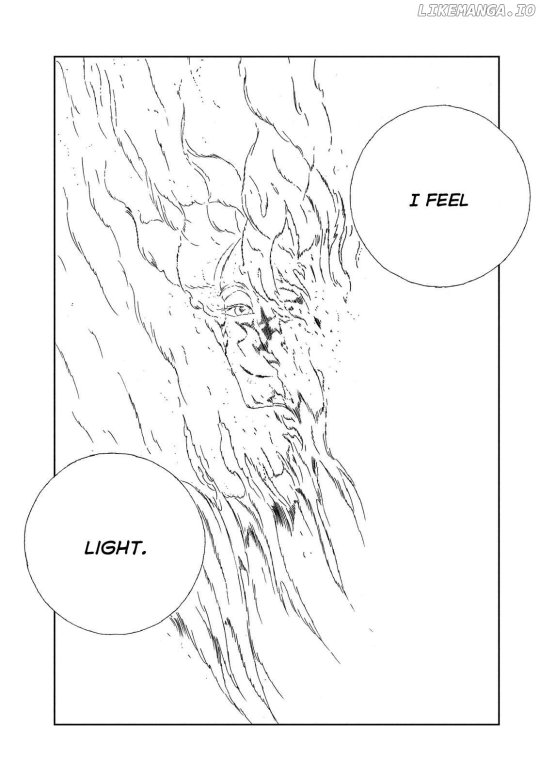
This is also the case for the last two pages.

The change in visual tone does a nice job emphasizing the literal and figuratively change in scenery. To be more specific, the drastic art style changes can symbolize the final metamorphosis of the remaining characters and the story itself. With Eyeball and the pebbles, the style emphasizes how they've transitioned to a whole new place in a literal and allegorical sense. And with Phos, they're style does the same by emphasizing on the deconstruction of their being during their final moments.
I apologize if what I said was confusing (I also got myself confused for a moment haha) But I'll just end this section with this: I liked the art in this chapter.
Now then, we should jump into the meat of this chapter....
Phos's final curtain call.
Phos Can Finally Rest...
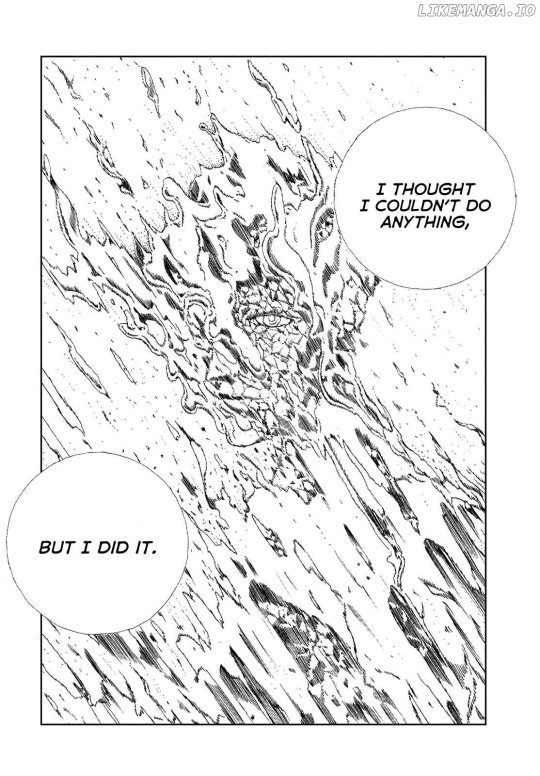
Like I stated before, I found Phos's pages really beautiful for different reasons. In terms of visuals, it's nice seeing some softer imagery after having nothing but sharp, chaotic ones. And story wise, it's nice to see Phos finally letting go and feeling fulfilled.

They are finally free, for real this time. Free from heartache, pain, existing. Phos is no longer held back by the sorrow they had been carrying, and they are free of regret.

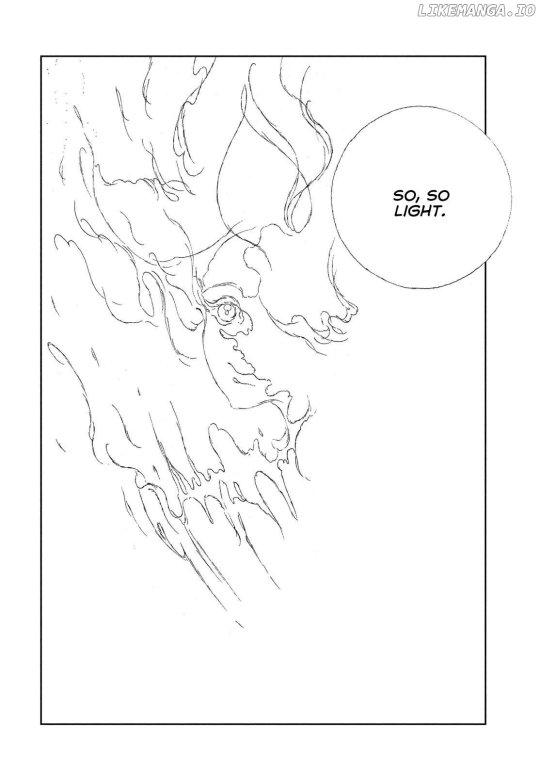
They are finally at peace.
And would you look at that? We got to see Pho's original face one last time. And they were happy.
Good for them.
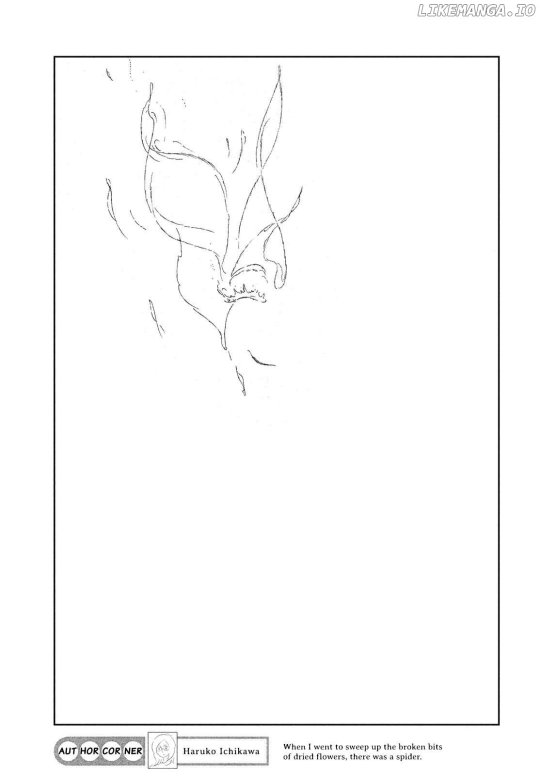
Before going to the next section, I want to quickly talk about this page:
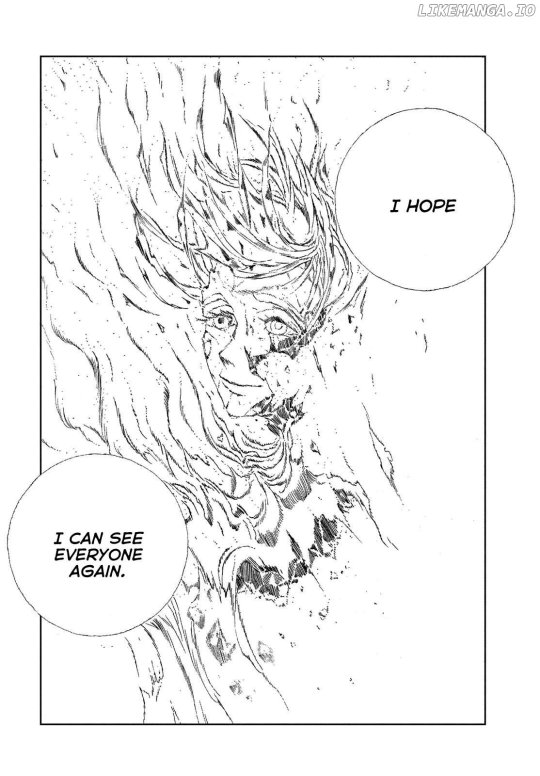
When I first looked through the spoiler tag for the previous couple of chapters, I remember seeing some posts from people who seemed unsatisfied with how the story progressed. From what I understand, many of them didn't like that Phos decided to forgive the remnants of humanity. With this latest chapter, I'm sure there are fans who were also not happy that during Phos's final moments that they are thinking about wanting to see their old families again. I can understand the sentiment, though I'm not surprised with this development.
Despite everything that had led the story to this point, Phos did not hate their old families. Yes, they harbored malice towards them during different points of the story, and it would have been justifiable for Phos to punish them along with the other remnants of humanity came to them to pray. But instead, Phos chose to forgive and free them.
I originally saw Phos's actions as their way of finally cutting ties with their families and relieving themselves of the emotional baggage that they burdened them with. But it's been hinted for a while that despite everything, Phos still loved their families. And the fact that Phos wishes they could see them again solidifies this fact.
Though I can't say if I like this revelation or not, I still find it interesting. But again, I can understand if some readers disagree with Ichikawa's writing decisions. If you have your own thoughts about Phos's final moments, please feel free to share them!
But regardless of everything, I still think this was a wonderfully fitting send off for Phos.
But I'm not done talking about Phos just yet.
And Start Anew...
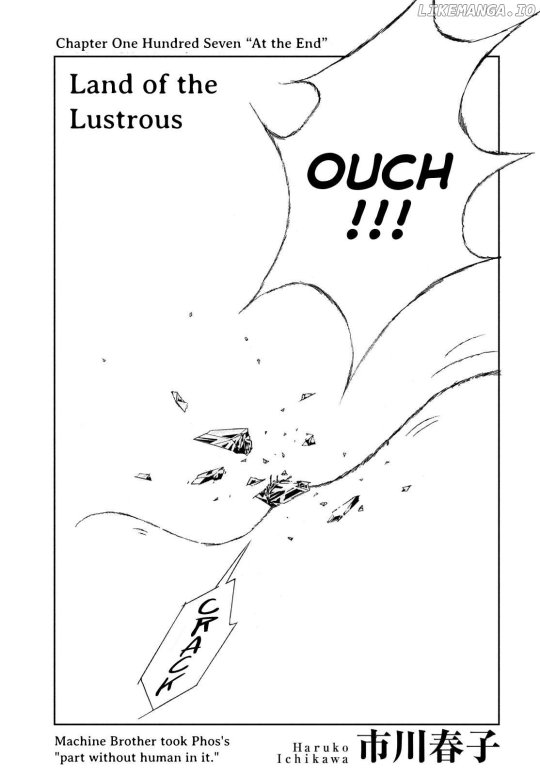
I'll admit that having the first image I see be Phos's last gem piece shatter was not the welcoming image I wanted to see. For a moment, I thought my hope that there was a chance the small piece of Phos would grow sentience and live a new life was shattered (haha.)
But hooray, for that theory became a reality! Despite Phos's last piece breaking up again, a small bit remained and is evidently showing signs of life. It was wonderful how the pebbles immediately recognized that small piece as their brother, showing once again how open and welcoming their are. Small Phos is so lucky.
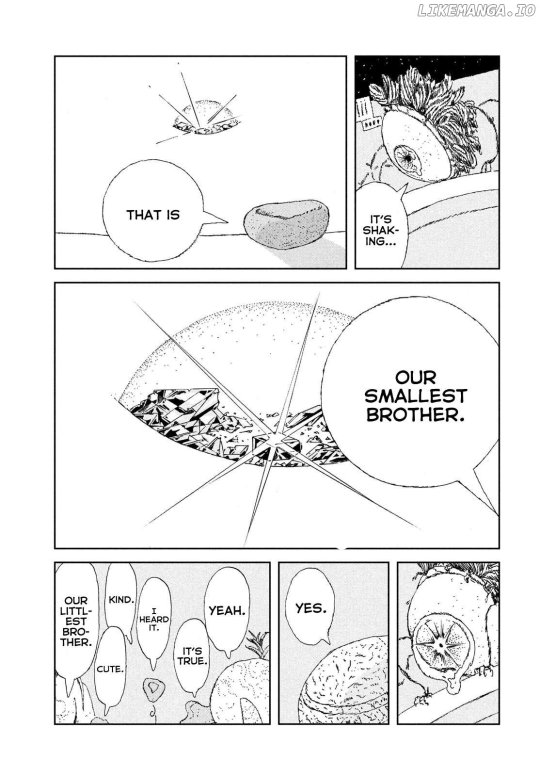
And how ironic is it that this Small Phos is considered the smallest, (in some ways) youngest, and most fragile new member of this new family... much like how Phos was with the gems at the beginning of this whole story. (I know that Phos was the same height as the other gems, but because of their makeup and position within their society, Phos can be considered less significant or "smaller" than everyone else)
Hm. With that thought in the air... I hope the parallels end there and this doesn't mean that this small and untainted piece of Phos won't be subjected to a similar treatment of their predecessor, right?
...right??
Nah, it should be fine....Unless Aechmea somehow comes back-
Created Their New Path: Final Act of Defiance?
The second to last thing I'd like to talk about is this page because it had me thinking about few things.
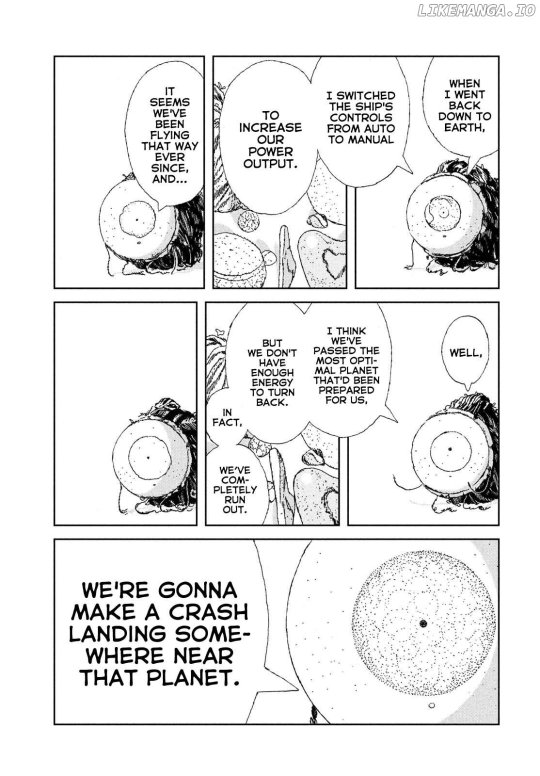
It made me think back to the previous chapters, namely the crazy, nearly perfect plans perpetuated by Aechmea and the Lunarians. It's been emphasized many times how calculated Aechmea's plans were, especially when it came to Phos. He nearly predicted every action Phos would make and kept planning and manipulating accordingly until things go the way he wants. And in the previous chapter, it was also heavily implied that he and the other remnants of humanity counted on Phos, Eyeball, and whatever new organisms they came across, to get onto the Dues Ex Machina ship. In some way, they predicted correctly.
But now I must ask these questions:
Did they also count on the possibility of Phos not entering the ship?
Did they also count on Eyeball switching off the ship's autopilot, manually controlling it, and subsequently crash landing it on a planet that more than likely wasn't the original destination?
For these questions, I want to say no.
It's interesting how even though at this point in the story, both Eyeball and Phos seemed resigned to the fact all of their actions were a result of them being manipulated, even after the perpetrators were long gone. But funny enough, I think that their very last actions were entirely their choice. For Phos, staying on the planet and ceasing to exist was entirely their choice. And for Eyeball, choosing to meddle with the ships settings to grab Phos's last gem piece and boost the ships' output. I don't think Aechmea counted on Eyeball doing that. If Eyeball is correct and they did pass the planet that Aechmea had possibly prepared for them, then this means that Eyeball had in many ways changed the trajectory of his and the pebble's lives, albeit unintentional. This could all mean that are all finally free from Aechmea and his long-game, 4D chess plans.
Phos and Eyeball have finally and truly defied Aechmea and humanity.
...BUT THEN AGAIN.. there's always that dumb chance that this was ALSO somehow part of Aechmea's plan. I highly doubt it, because that would be very ridiculously convoluted, even for this story. But then again, you never know with this author.
But for the sake of this post, I want to believe Phos and Eyeball came out on top in the end by intentionally and unintentionally forging paths that wasn't previously made for them. Even though Phos's final choice was somewhat influenced by the professor, it still felt like it was truly their decision.
I hope this doesn't unravel somehow with the final chapter.
Speaking of which-
The Final Stretch...
I can't believe it. This story is about to end. We'll finally almost done and what a journey it has been. I can't believe I started getting into this series almost over 6 years ago. Many things have happened since then, and during this time, this story had sent me on such an emotional rollercoaster. Though there are many things within the story that I wish was different or handled better, I still think this was a very wonderful and thought provoking story.
Now Ms. Ichikawa has to stick the landing. This could make or break this series.
After everything you put us readers through, I hope the true finale will be worth it.
#houseki no kuni#land of the lustrous#hnk#hnk spoilers#hnk phos#hnk spoiler#lotl#hnk meta#lotl spoilers#hnk analysis#hnk chapter 107#hnk phosphophyllite#hnk manga#hnk thoughts#story analysis
50 notes
·
View notes